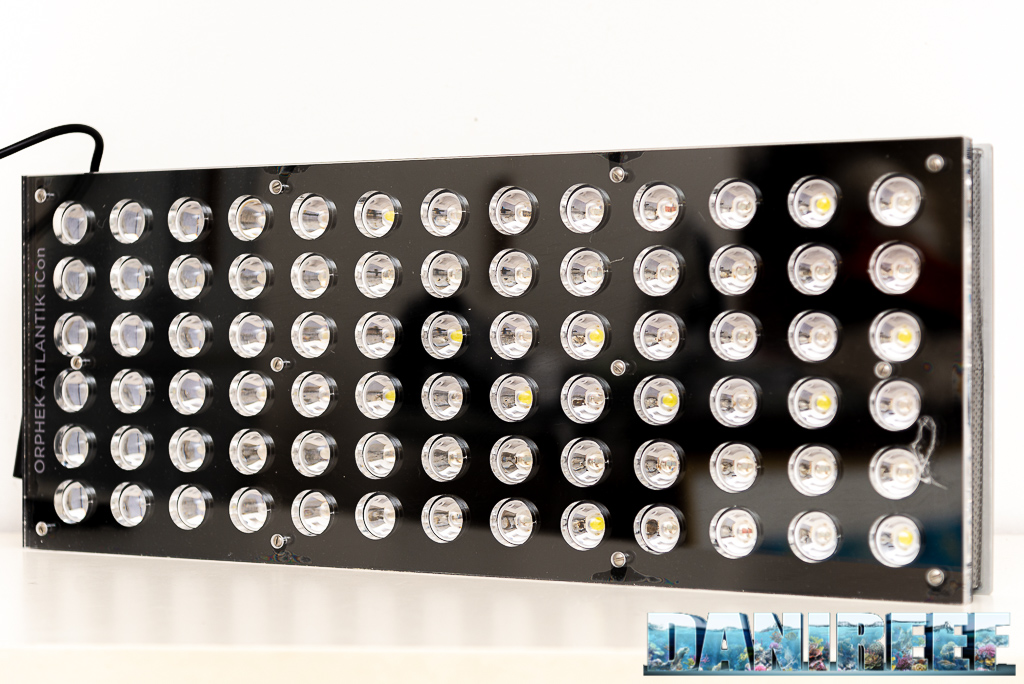
Orphek has updated its best ceiling light with lots of changes and, in particular, more power. Come and discover it in our DaniReef LAB.
The light is almost completely different. Aesthetically, there’s a difference in the shell: on the top, with the ceiling light off, it’s changed from black metalcrylate to aluminum. Honestly, I like it more this way. Maybe it’s less elegant, but it seems way more solid. The second big news is the absence of the gateway, because now the light has a bluetooth-wifi module integrated, and like the Radion, it’s now super fast to catch a signal and react to the controls. Also, like everything else, many things about the LED lights themselves have changed. The Atlantik V4 had 14 different LED, and now it has 10. After the experience with the phenomenal Blue Sky bars (here) they adopted a similar configuration. Fewer types of LED but studied even more thoroughly. The result is 230 watts of power and an incredible level of PAR both at 40 and 60 cm. Record breaking! Finally, Orphek improved the one and only Achilles’ heel of the Atlantik V4. There are now 6 LED channels, and compared to the previous 4 it makes a great difference in the possibilities of the various sets and now it’s possible to set the moonlight between 0.1 and 1%. I’ve never seen such a possibility of dimming.
We were very curious to test it in our DaniReef LAB. The only thing left is to see the results!
Technical characteristics of the Orphek Atlantik iCon
The ceiling light is rectangular, 5.4 cm of height, and with a base of 61.5 x 23.8 cm. The LEDs, as we have said, are of 10 different typologies, grouped in 6 channels. The moonlight is managed by lowering the overall power.
| Orphek Atlantik iCon | |
| Length | 61,5 cm |
| Width | 23,8 cm |
| Height | 5,4 cm |
| Consumption | 230 watt |
| LED Configuration | |
| Whites 18.000°K | 18 |
| LED infrared 730 nm | 2 |
| LED orange 590 nm | 4 |
| LED cyan 490 nm | 6 |
| LED blue 470 nm | 9 |
| LED blue 450 nm | 13 |
| LED purple 430 nm | 6 |
| LED purple 420 nm | 7 |
| LED purple 415 nm | 7 |
| LED purple 400 nm | 6 |
| Total LED | 78 dual chip of 5 watt |
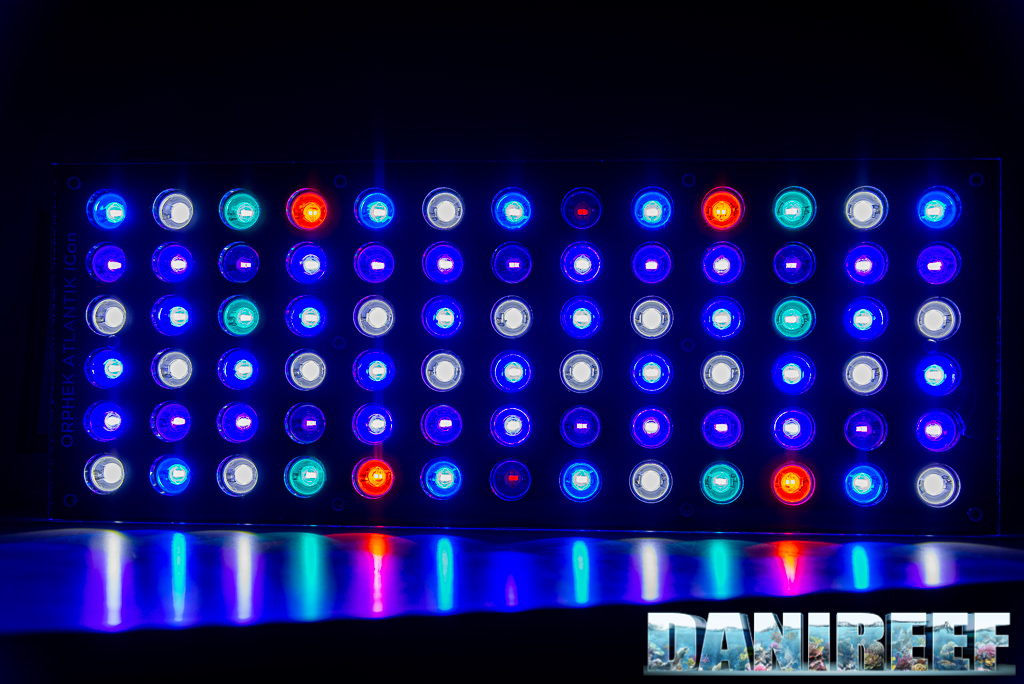
Our video about the Orpehk iCon
I tell you, this video is very long, so sit back and make yourselves comfortable. After the unboxing we speak about the power. The video is in Italian, but you can add the English subtitles.
You’ll find the same analysis below, plus the comparison with other ceiling lights.
Construction
As expected, the ceiling light is very well built. It has 4 vents of 8 cm on the top that let the fresh air in. The controller is included and is accessed with the new iCon app.

Programming through the iCon app
The configuration is very very easy, as you can see. Also, if you’re curious to see how it behaves interactively, in our video we test and compare the set up with the PAR of other ceiling lights.
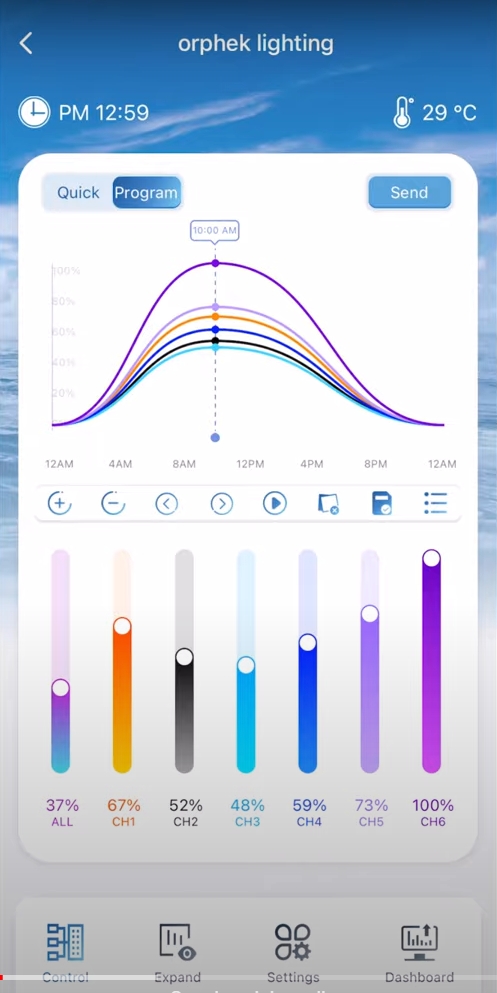
Inside the app, that in the picture is in quick mode, you can see the temperature of the PCB of the ceiling light, the hour, but not the power of the ceiling light or of the LED.
Channel 1: Dawn and Sunset (6000K)
Complete spectrum of the channel: from 400 to 780 nm. This channel has been designed to mimic the natural color of dawn and sunset. They have the warmest colors, obtained with 7 white LED of 18000 K, 2 infrared LED of 730 nm and 4 orange LED of 590 nm, for a total of 6158 K.
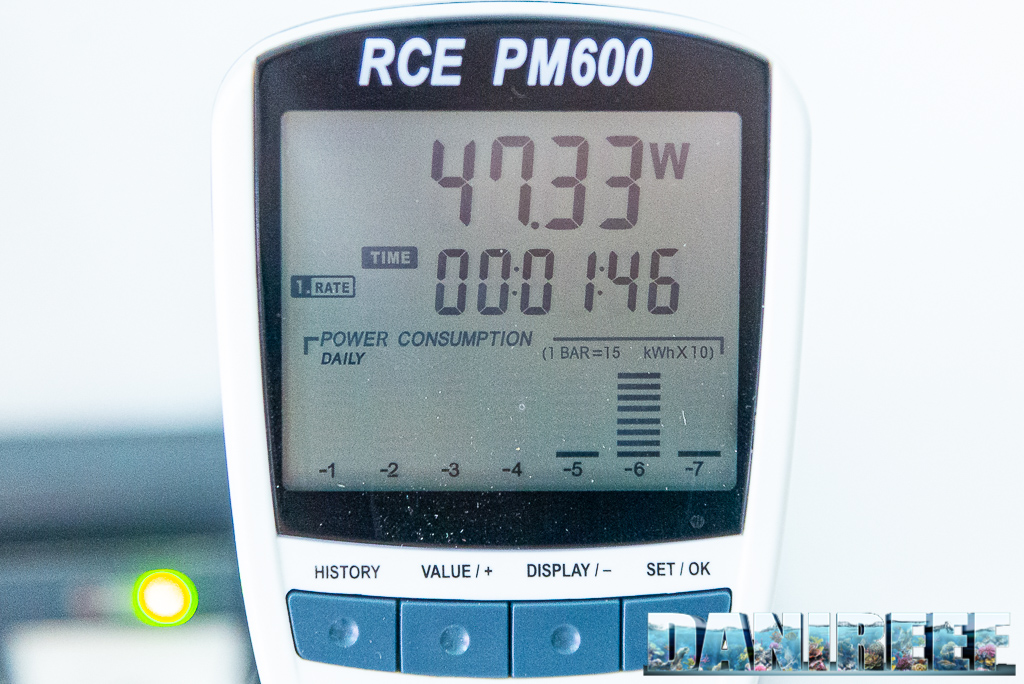
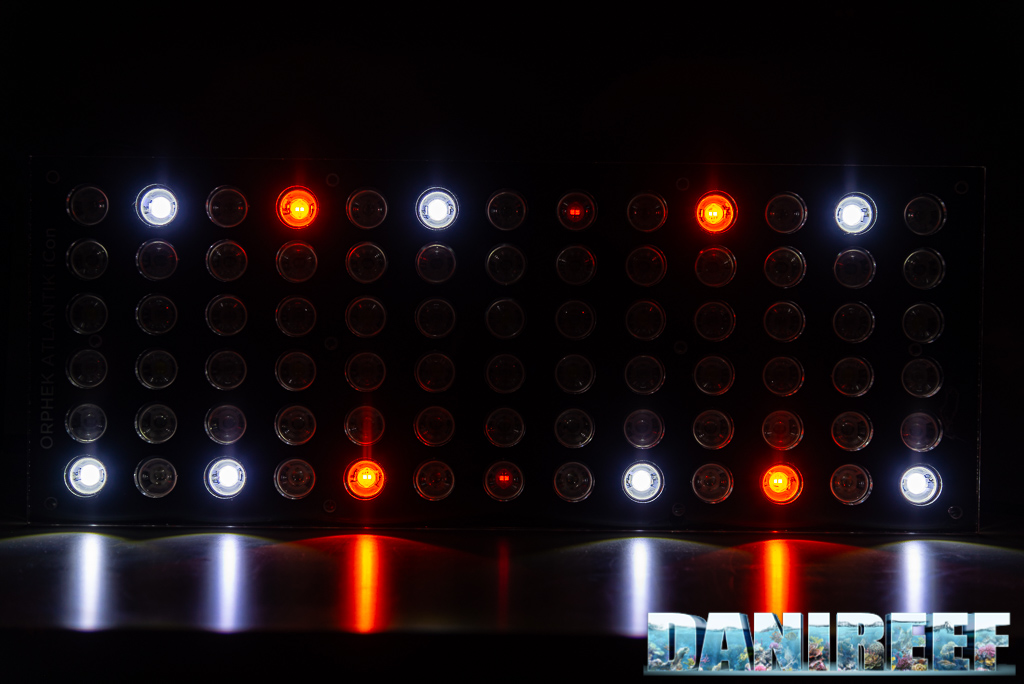
Channel 2: Solar Noon (18,000K)
Complete spectrum of the channel: from 400 to 700 nm. The intent is to recreate the natural coloration between dawn and sunset. This channel has11 white LED of 18000 and 2 cyan LED of 490 nm, for a total of 17905 K.
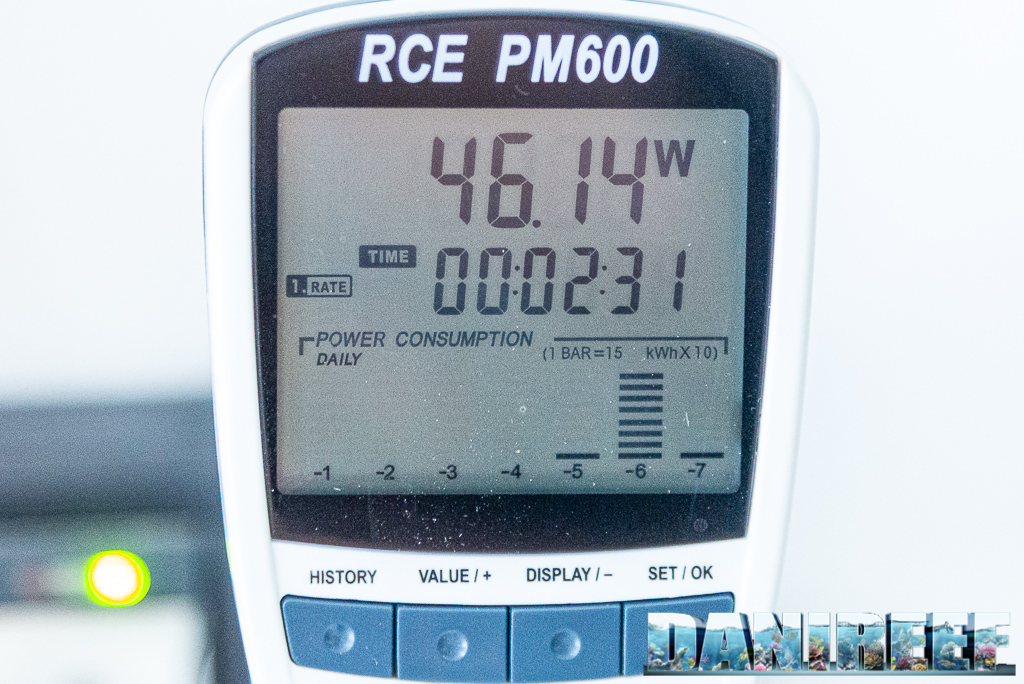
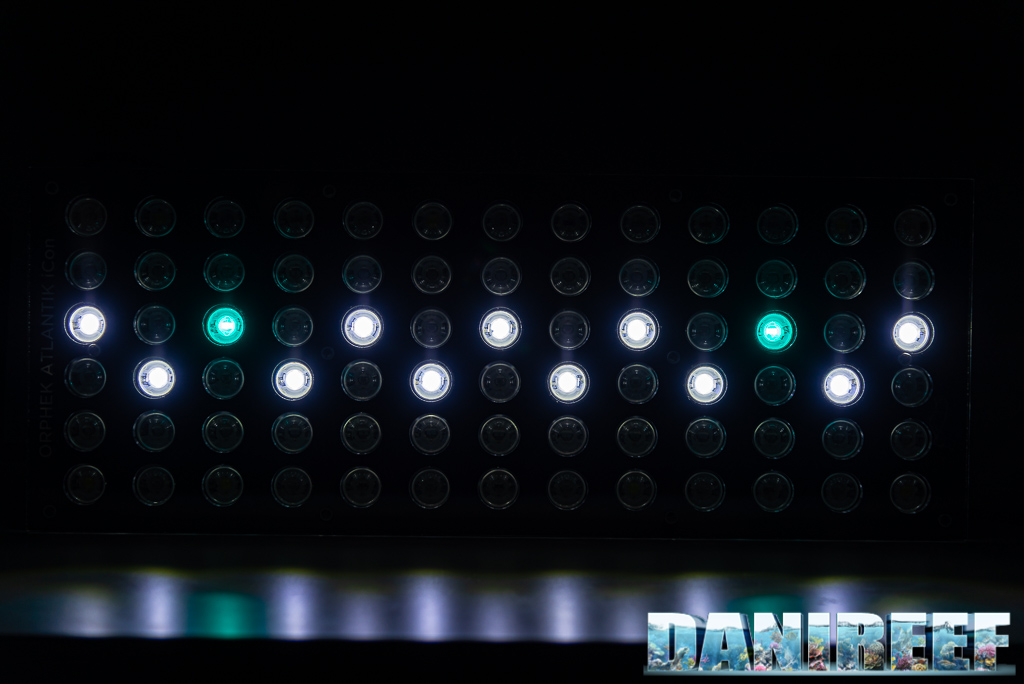
Channel 3: Cyan blue (490nm, 470nm) symbiotic protection
This channel recreates the natural color of the sea water under pretty clear sunlight. It has 4 LED of 490 nm and 9 LED of 470 nm.
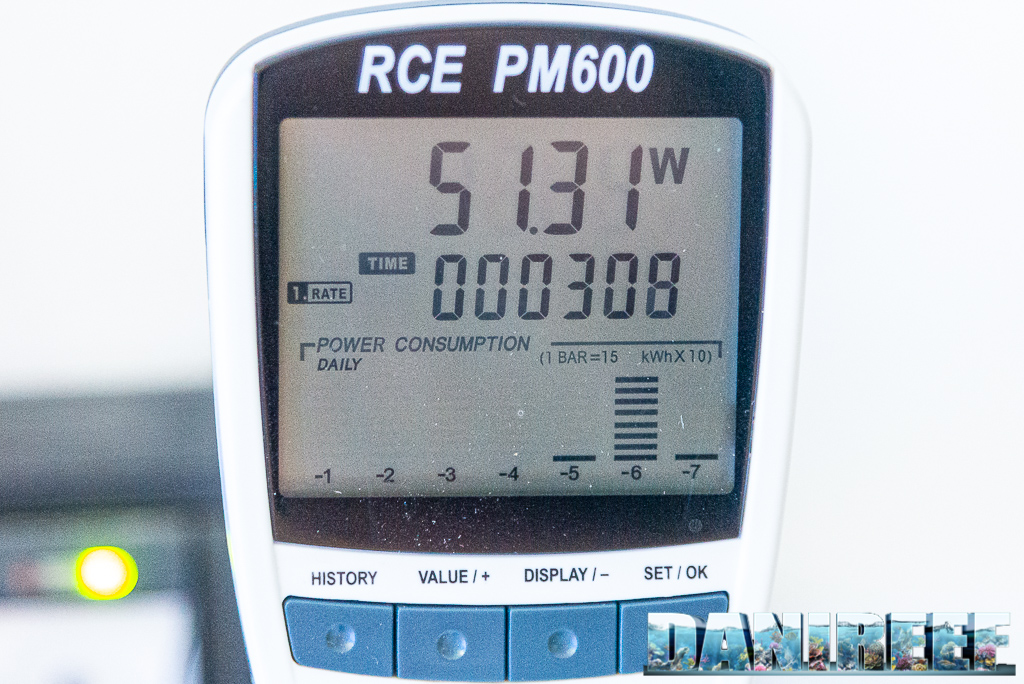
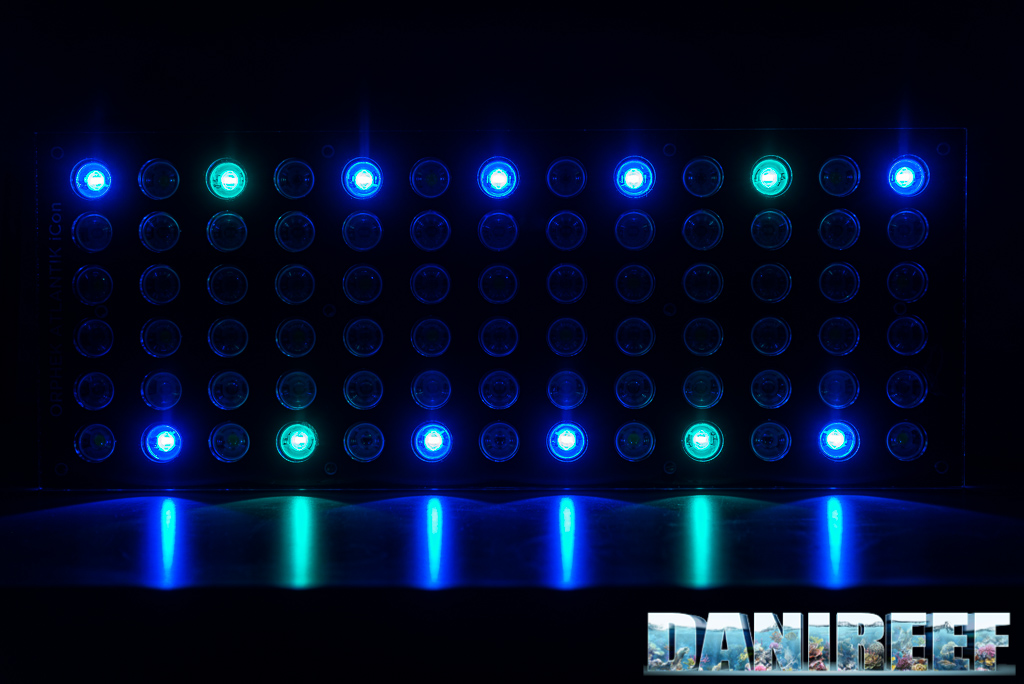
Channel 4: Blue (447nm) Chlorophyll c2
The color is a deep blue. The chlorophyll absorbs this light and uses it for photosynthesis. This channel has 13 LED of 450 nm.
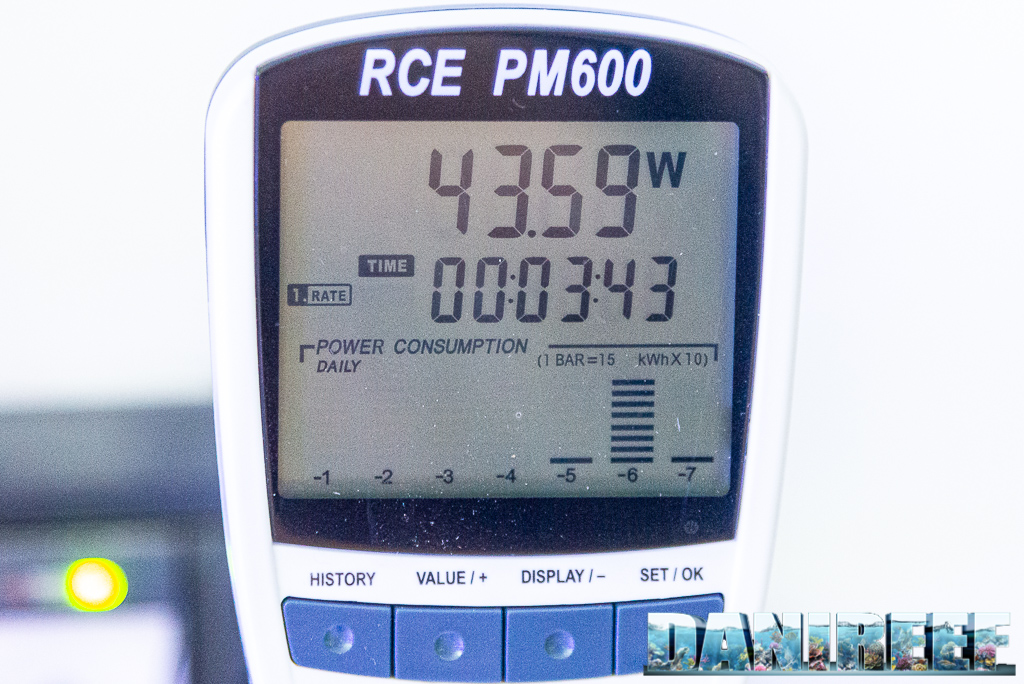
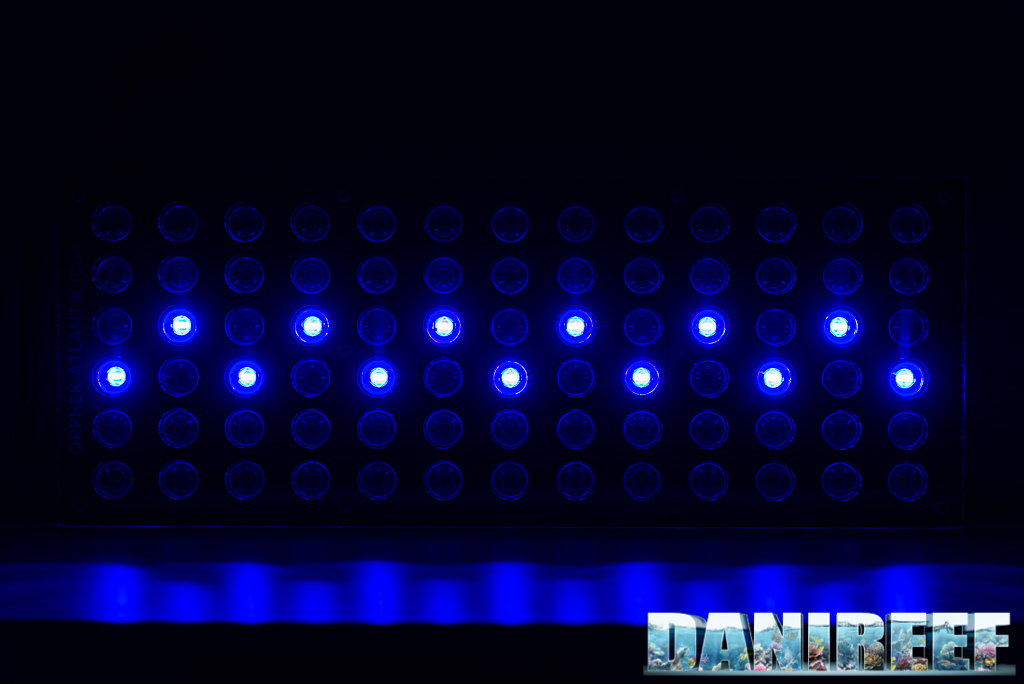
Channel 5: Purple (420-430 nm) chlorophyll a and c2
This channel has 6 purple LED of 430 nm and 7 purple LED of 420 nm. The wave lengths of 400-430 nm are very useful in photosynthesis: they can be absorbed by chlorophylls a and c2. A wide purple bandwidth of 400-430 nm has been found to be essential for the activation of fluorescent proteins.
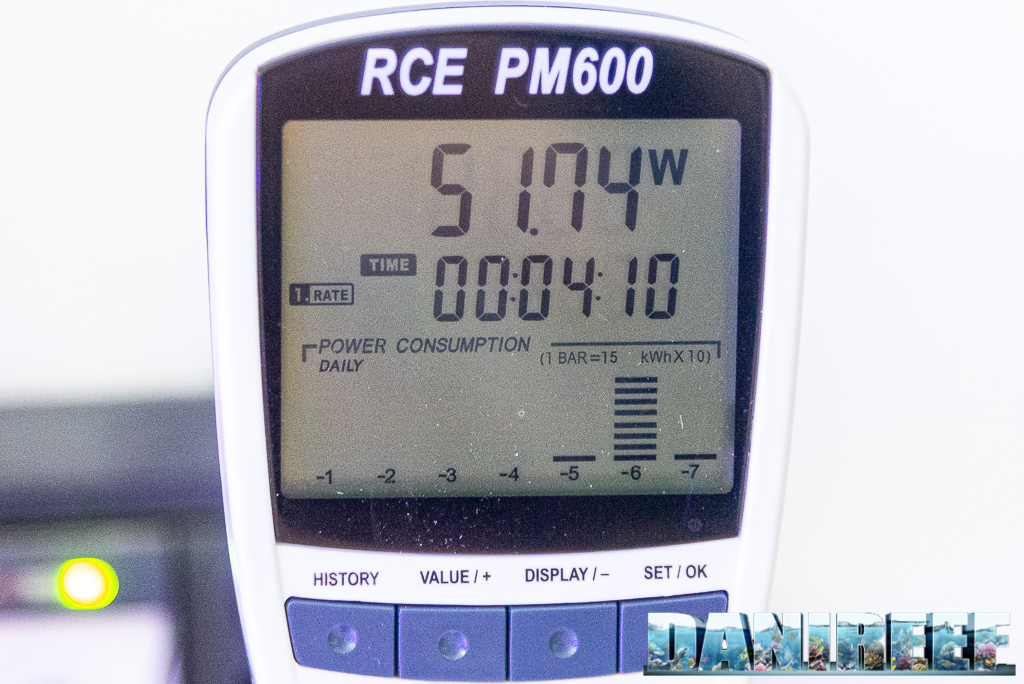
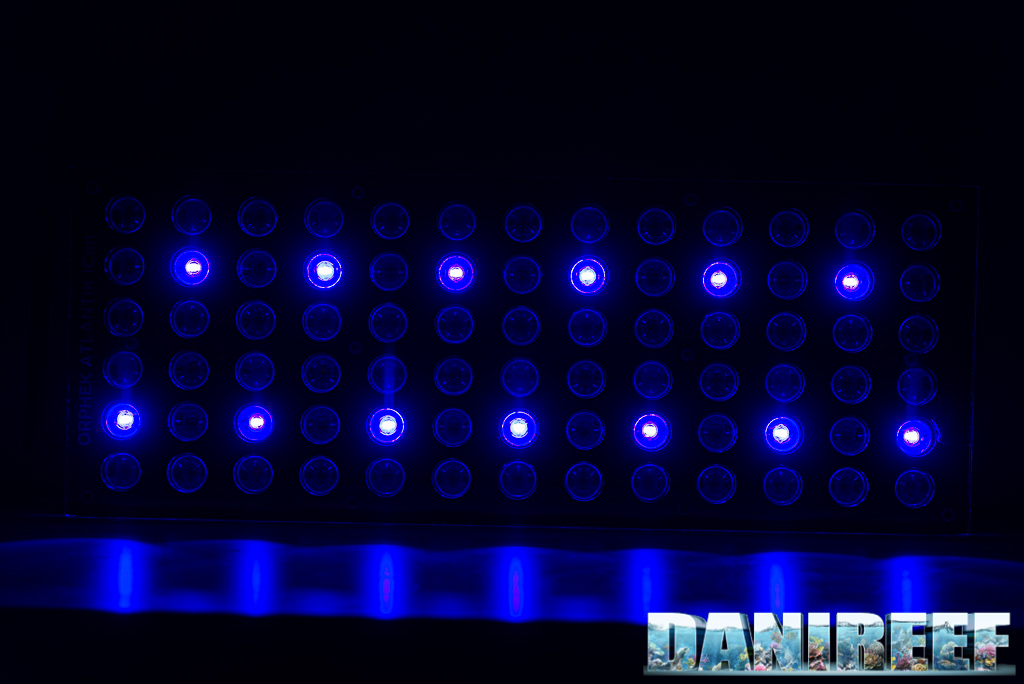
Channel 6: UV/purple (400-415 nm) Chlorophyll a
This channel has 7 UV/purple LED of 415 nm and 6 UV/purple LED of 400 nm. These wave lengths are very useful for photosynthesis: they can be absorbed by chlorophylls a and c2. They can also excite fluorescent proteins present in many corals.
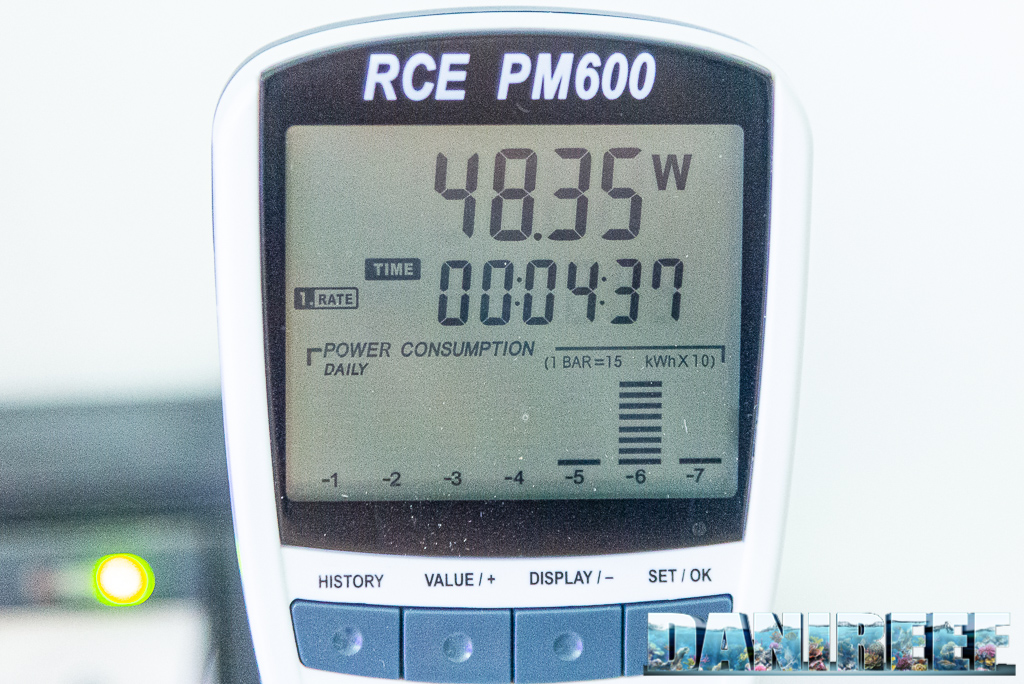
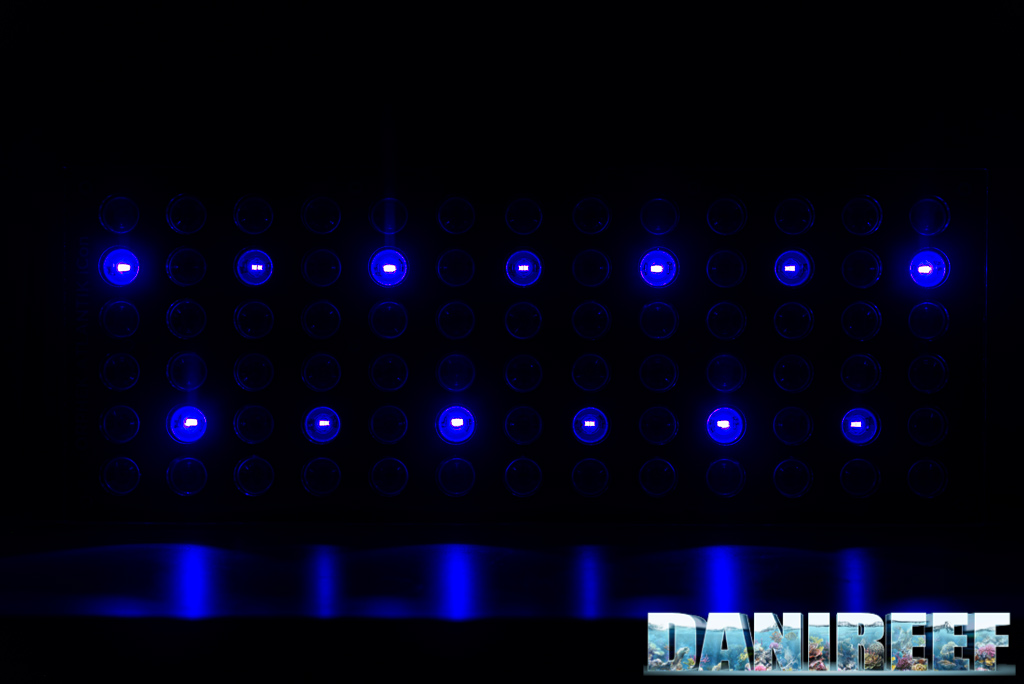
Final result
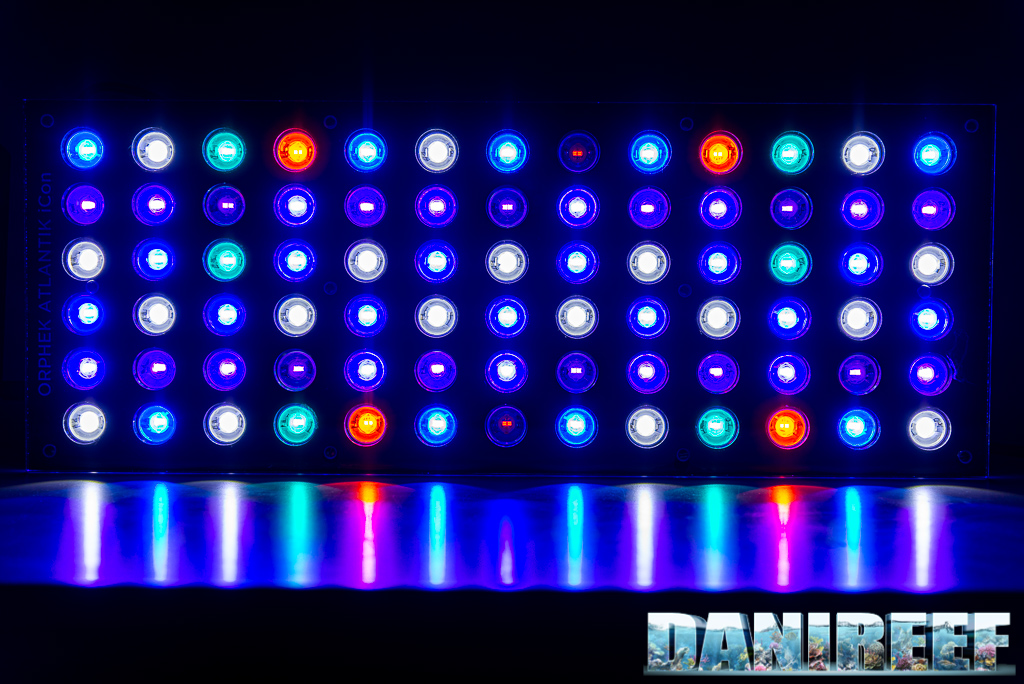
Our new method DaniReef LAB for PAR measurement of the Orphek Atlantik iCon
Interesting fact: During the long nights spent on our forum we always wondered how could we compare PAR from different ceiling lights. Even though we had the perfect device, the Quantum Meter MQ-510 from Apogee, we only measured the value at the center at 20 cm of distance, more or less.
The Quantum Meter MQ-510 measures the PAR, expressed in PFFD (photosynthetic photon flux density) in μmol m-2 s-1. This device is calibrated to work underwater, so if it’s in air, the measured value has to be divided by 1.32, which is the dive factor. We have to do the conversion. The values you’re going to see are correct.
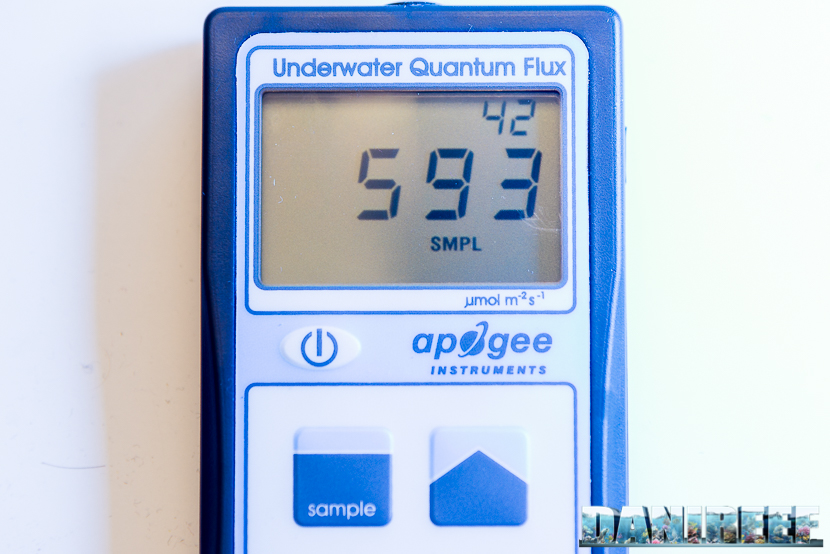
We decided to make a square base of 70×70 cm, we set 17 fiducial points where we placed the Quantum Meter MQ-510 and we also made 3 lifts of 20, 40 and 60 cm for the ceiling light, in order to have the same distance from the sensor. This will allow us to create the curves which can be compared to other ceiling lights, all tested at the same distances. Note that this distance is measured between the base of the sensor and the ceiling light. In reality it should be decreased by 3.5 cm, which is the height of the measurement cylinder, and increased by 0.5 cm, which is the dimension of the spacers that lift the ceiling light.
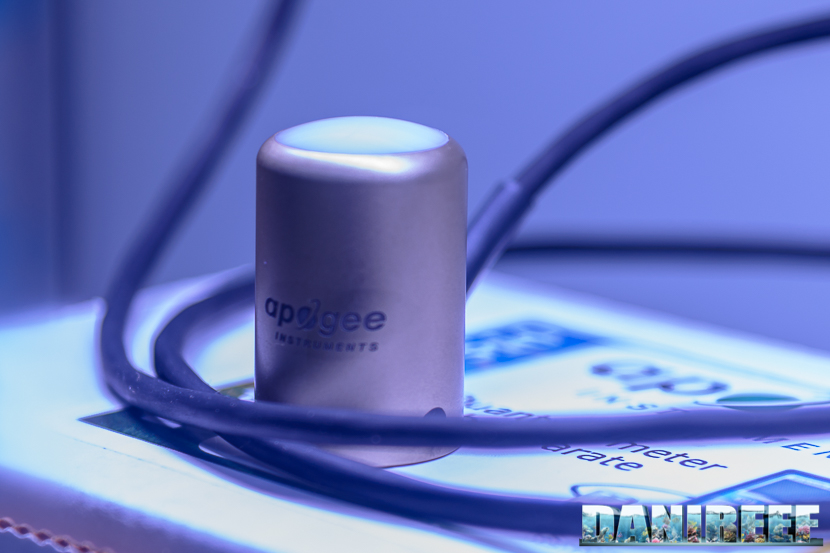
In total the three measurements are made at distances of 17, 37 and 57 cm. Because they are being done in air, they will be corrected.
PAR measurement at 17 cm of distance
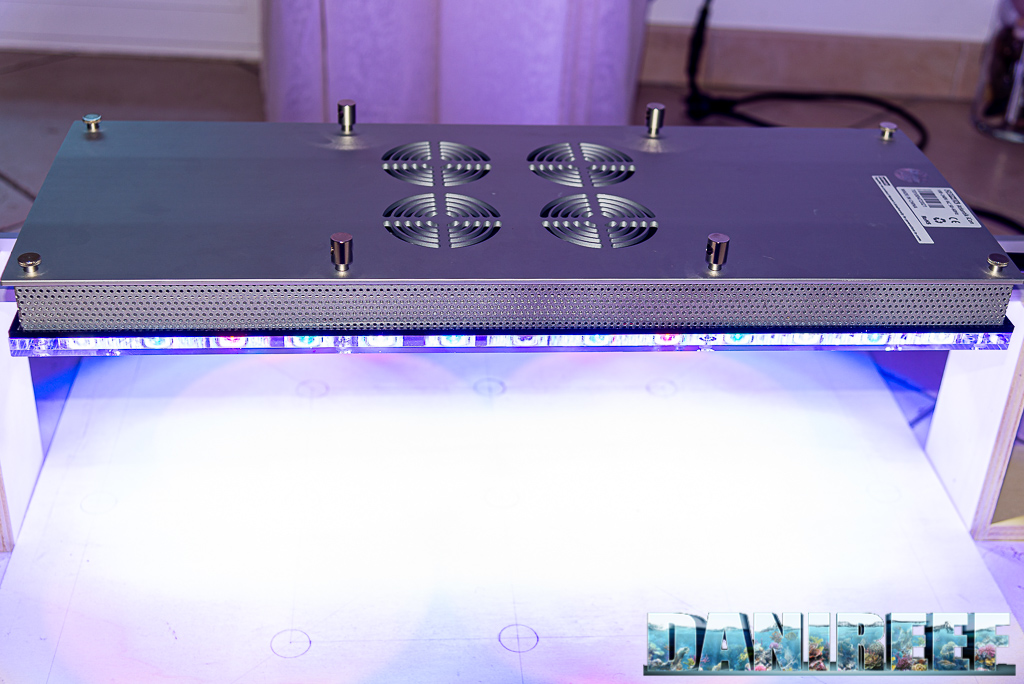
The ceiling light has been placed at 17 cm away from the display. The points not indicated on the panel have been estimated in the following chart.
Here are the collected values:
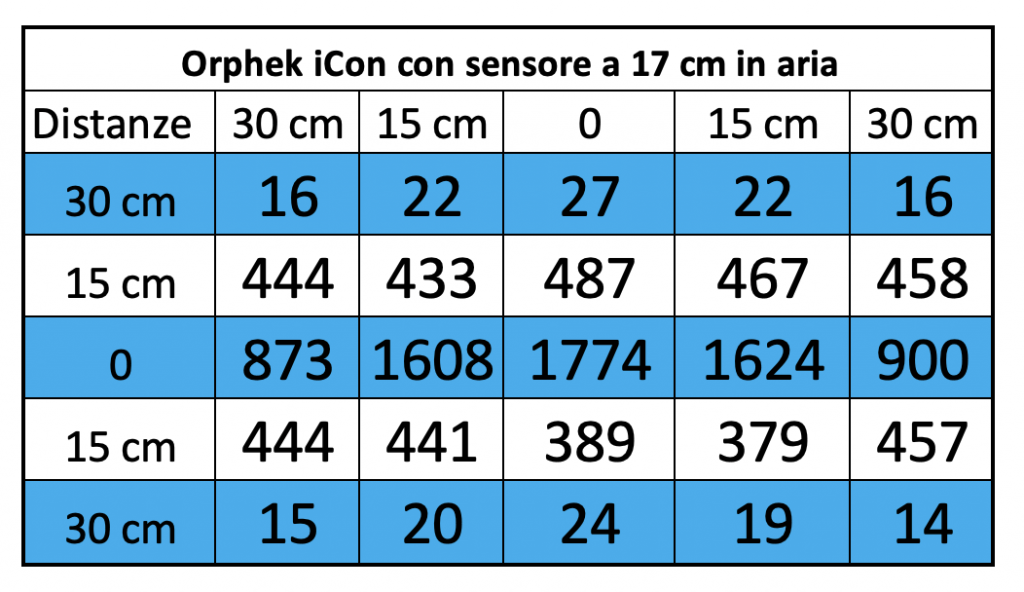
And this is the corresponding chart. We are using the same scale for ceiling lights with similar power.
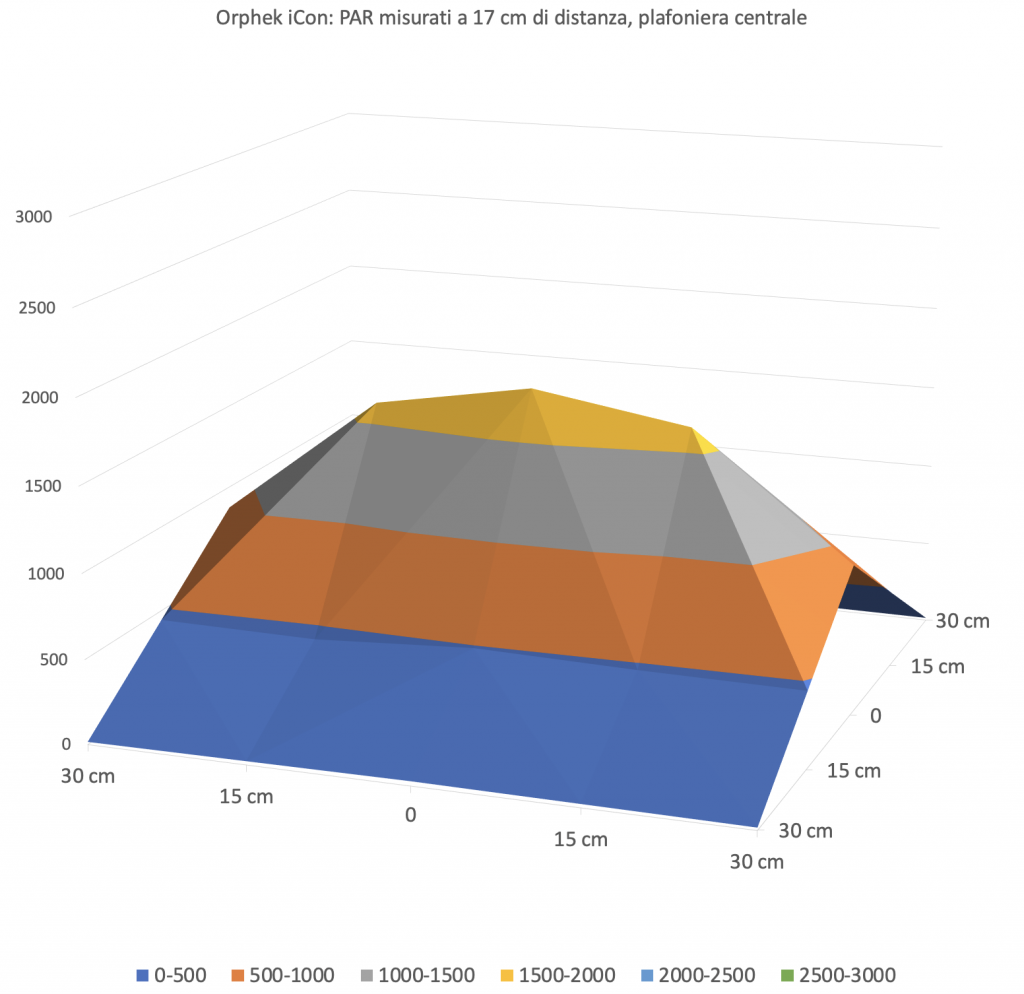
The first measurement has the shorter distance between the sensor and the ceiling light. The values of the expressed PAR are very high at the middle but very full along the entire length too, while at the front and back they drop abruptly. This is because of the size of the ceiling light: 61.5 x 23.8 cm.
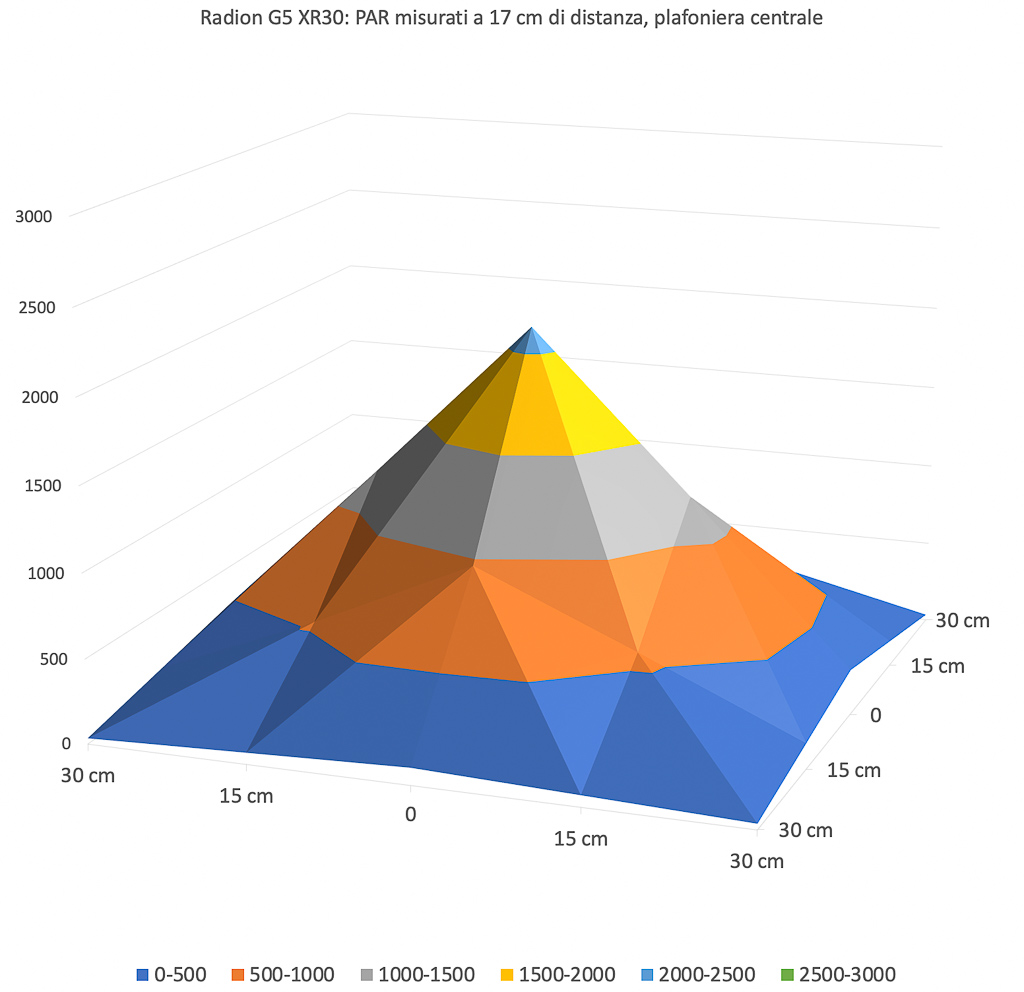
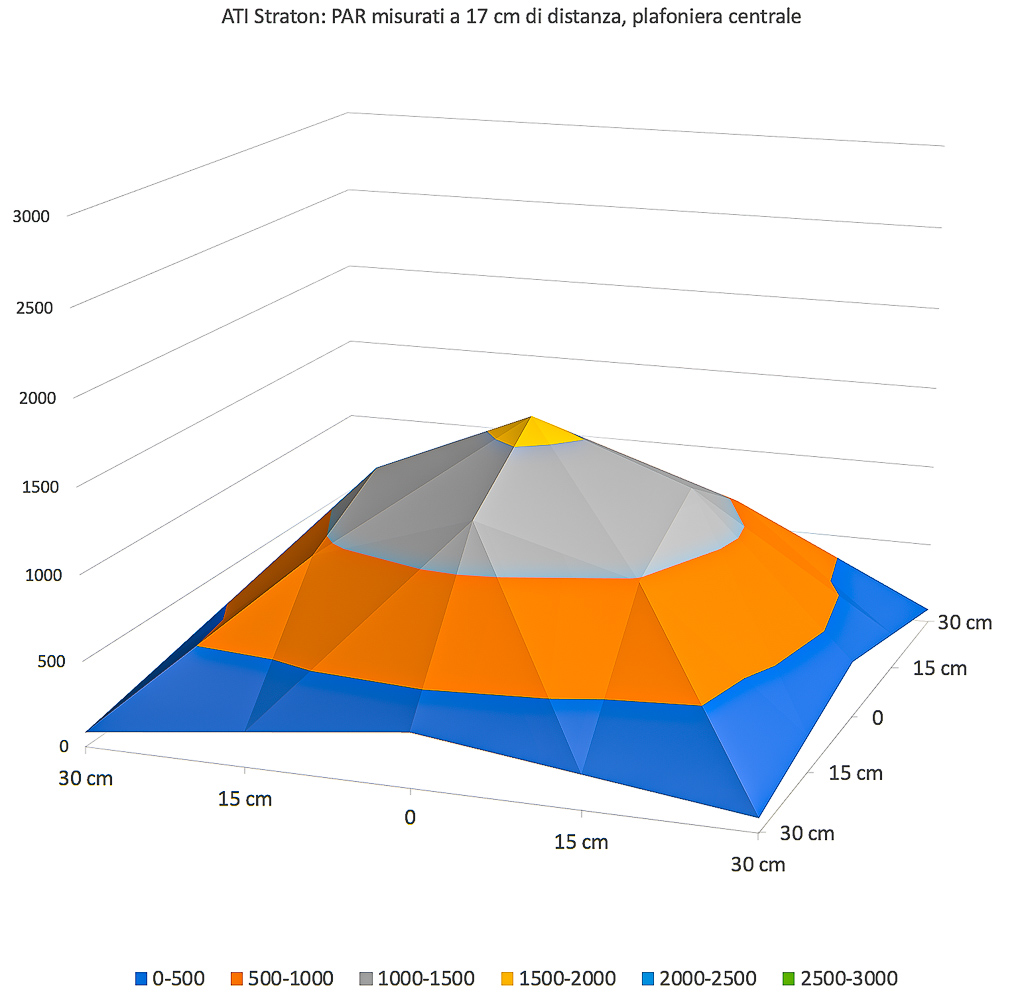
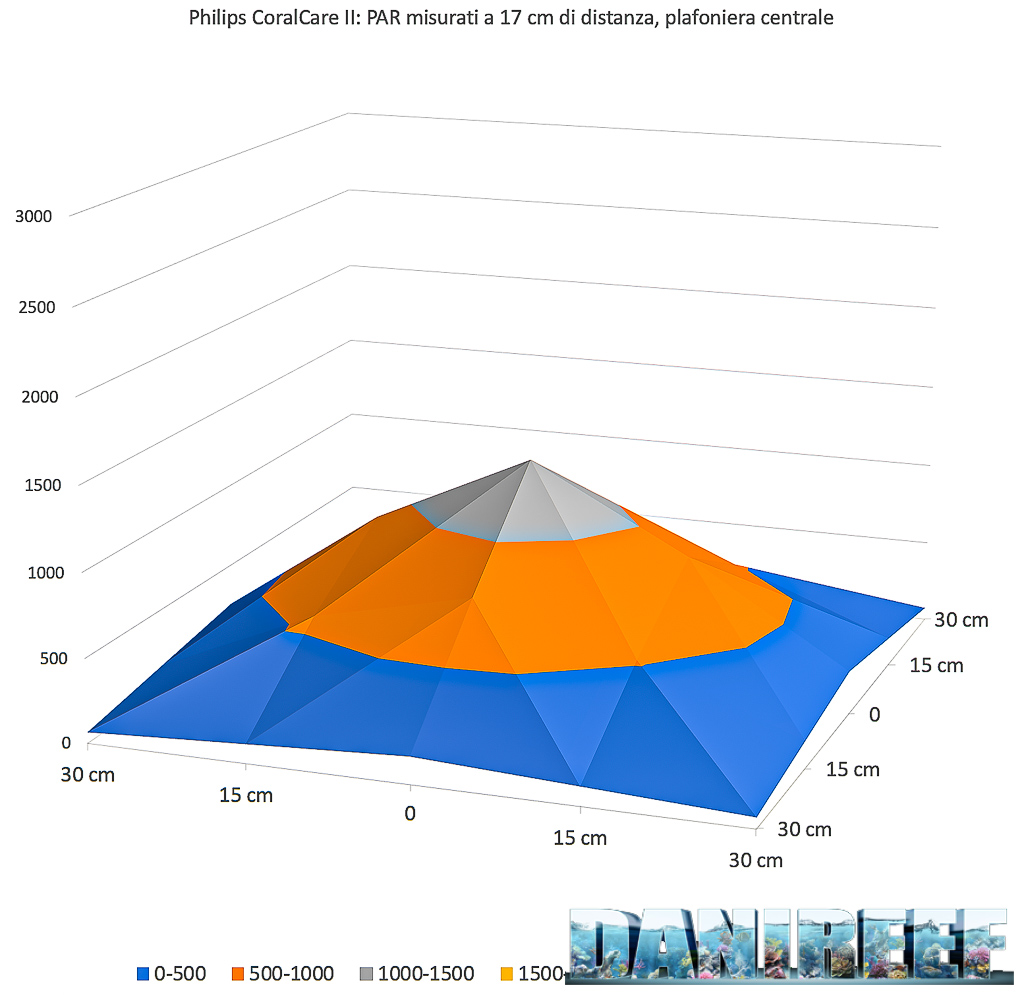
The charts have the same scale and colors when the PAR are comparable. Compared with three similar ceiling lights (even with different consumptions), the Radion stands out for its peak power. On the other hand, the ATI and the Philips reach a better coverage at the front and back.
PAR measurement at 37 cm of distance
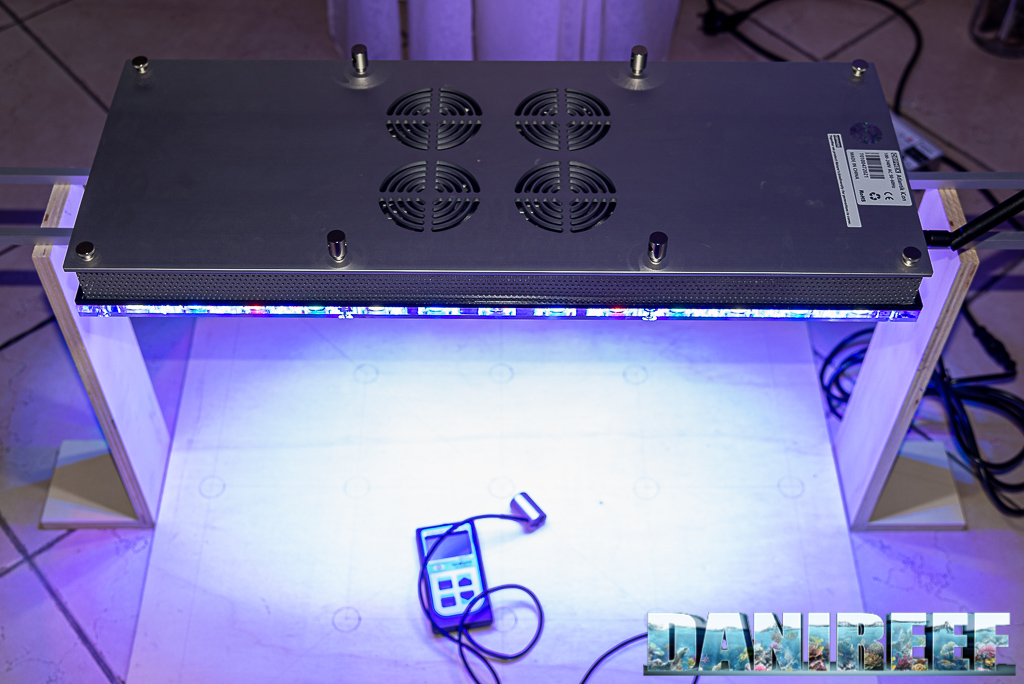
Then we placed the light at 37 cm of distance.
Here are the collected values:
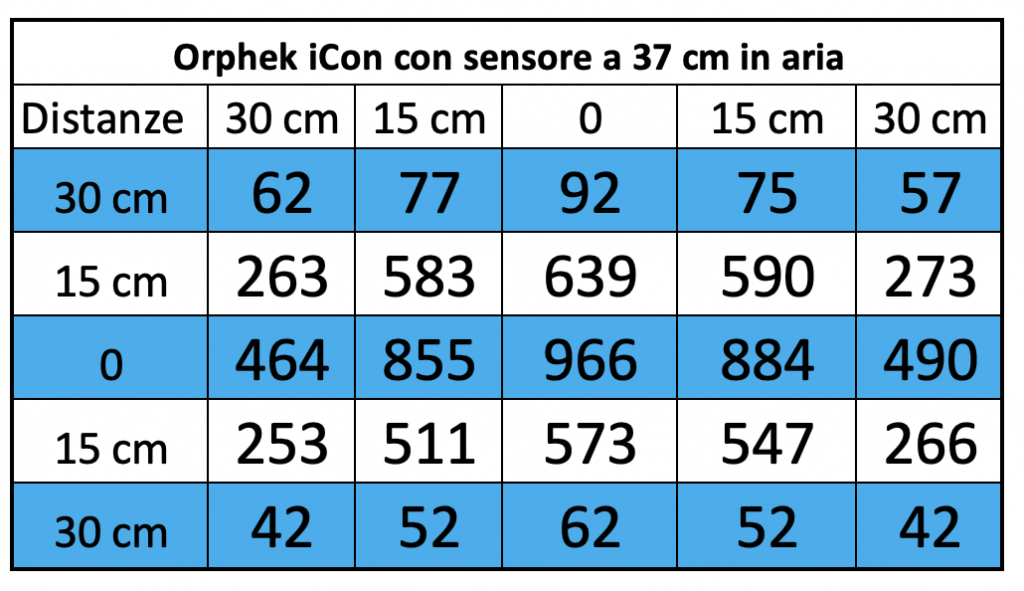
And the corresponding chart.
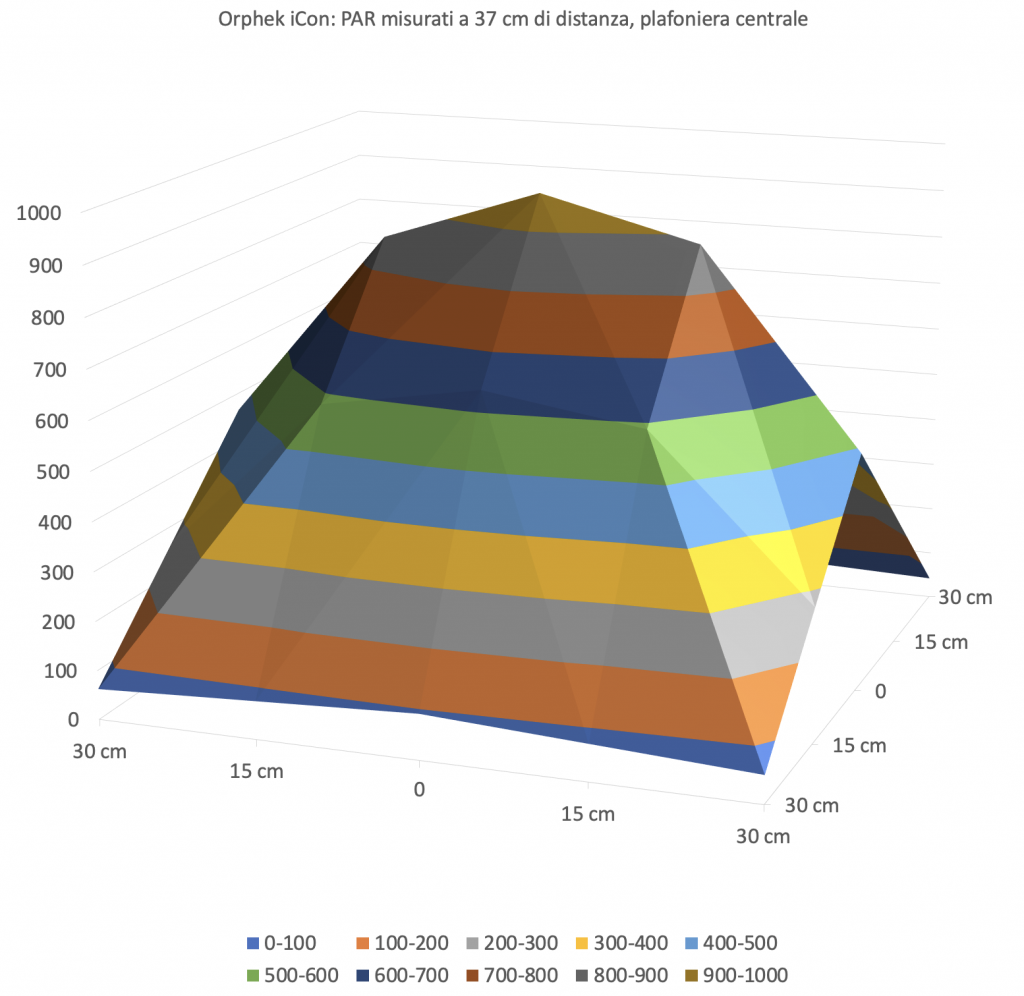
With a bigger space between ceiling light and sensor, the curve becomes more homogeneous. The peak value is incredibly high, given that it approaches 1000 PAR! The value in the middle decreases from 1774 to 966 μmol m-2 s-1.
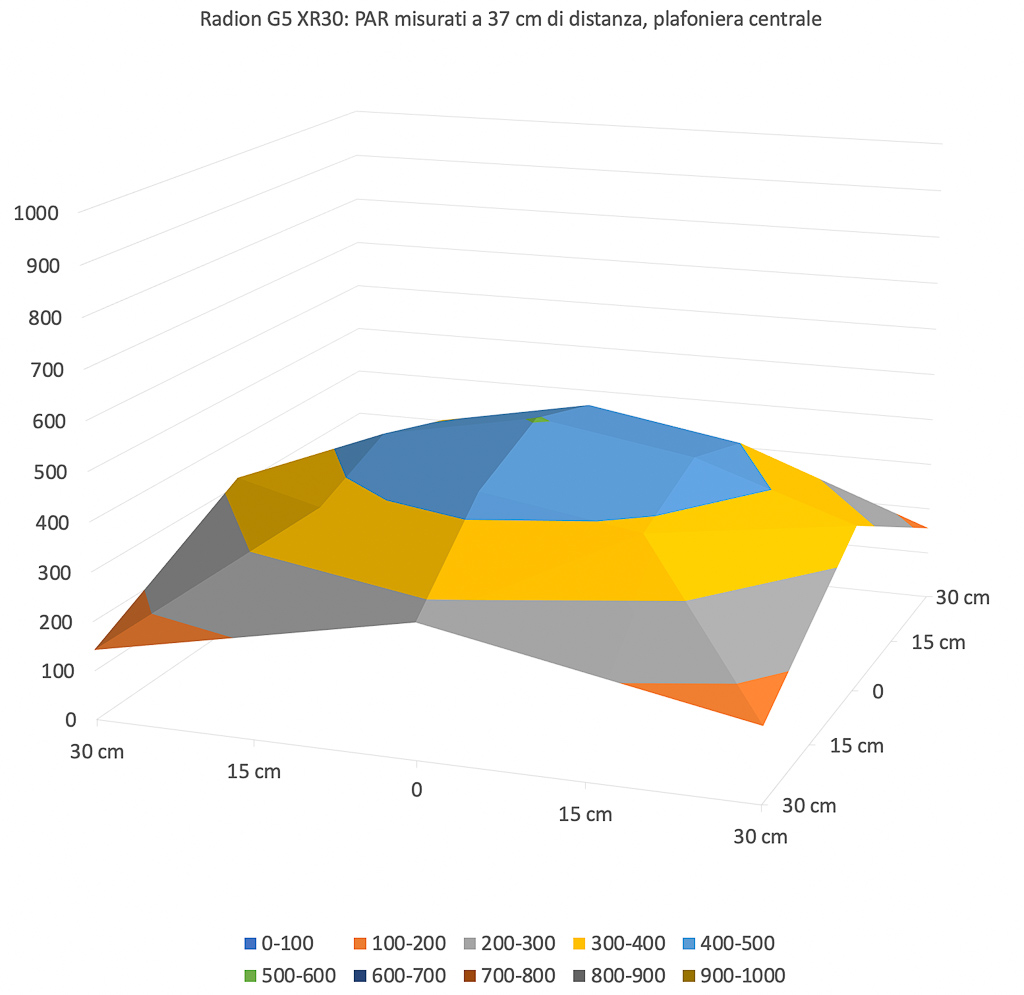
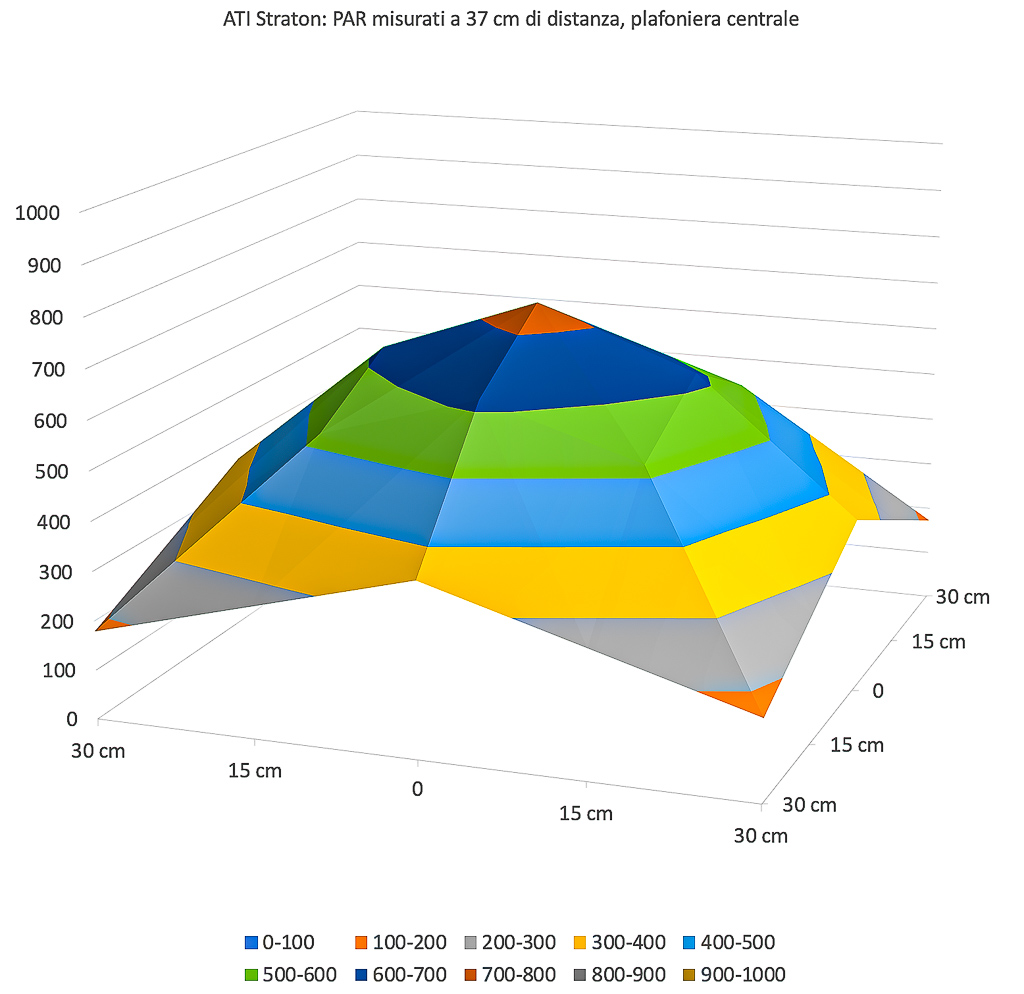
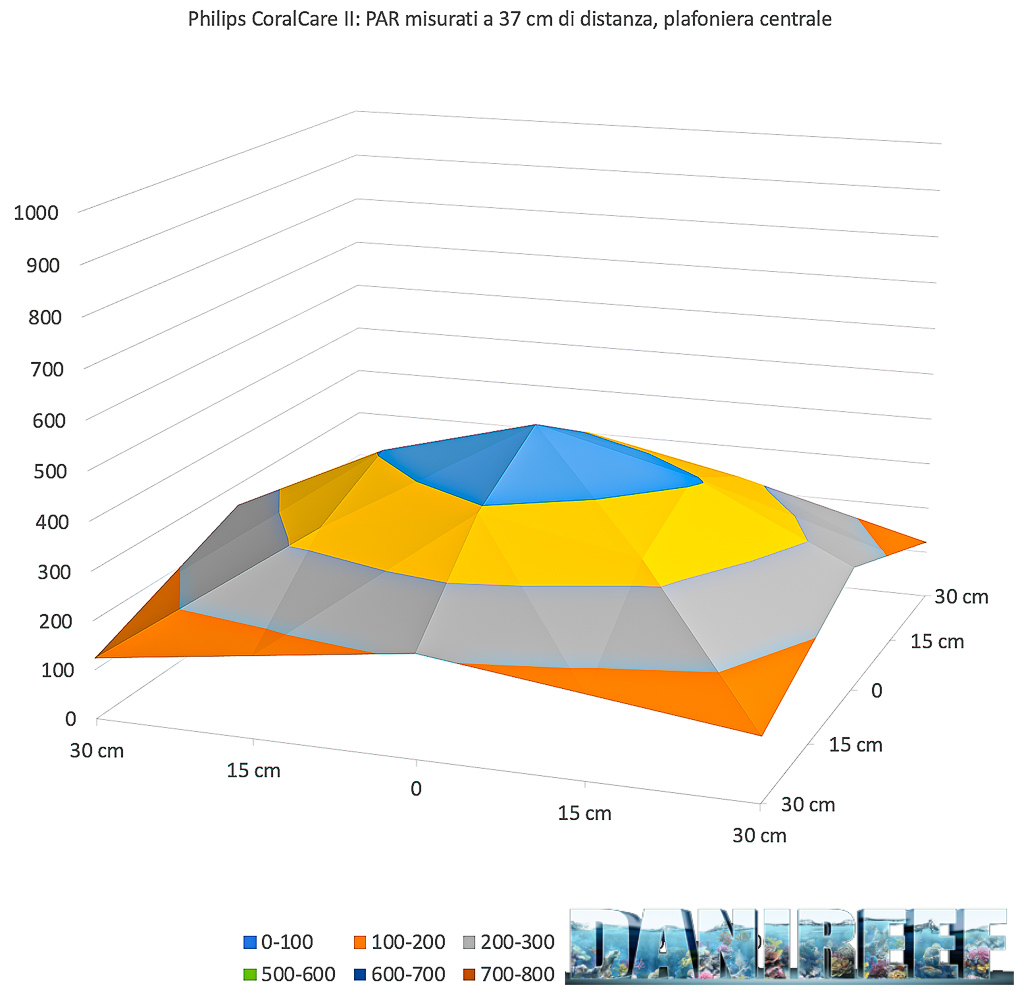
At this distance, the power is record breaking! The competitors, even with slightly less power, reach half of the value, except for the Straton. On the sides, the Orphek is still the best, but at the front and back it drops more the the others. For uniformity the Philips is still the winner, even if it has less power than all the others.
PAR measurement at 57 cm of distance
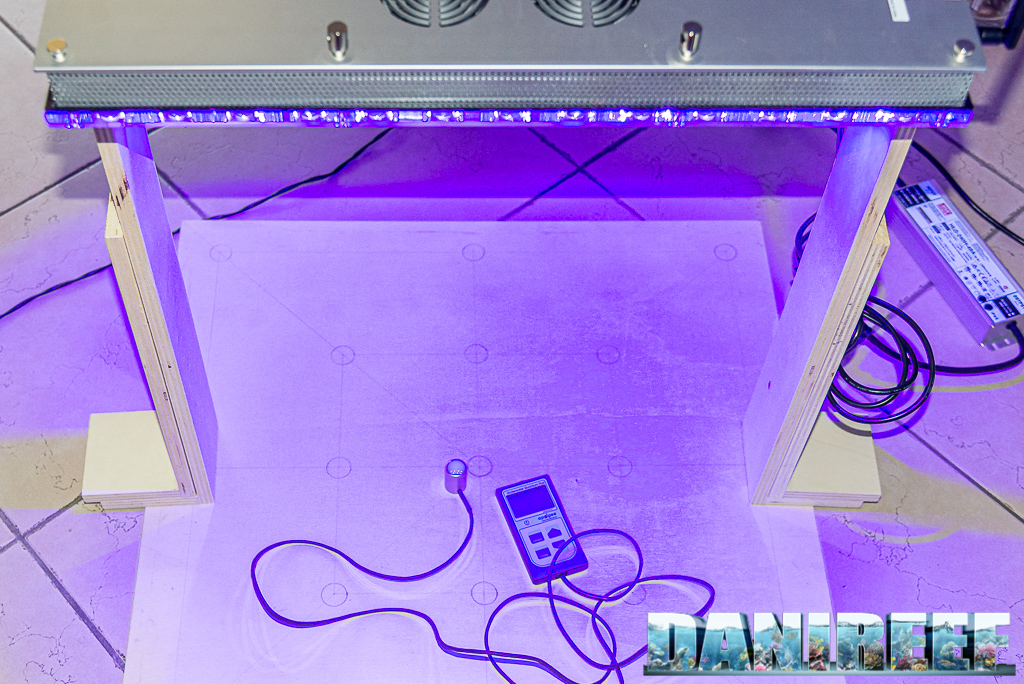
Then we placed it as far away as possible, at 57 cm.
Here are the collected values:
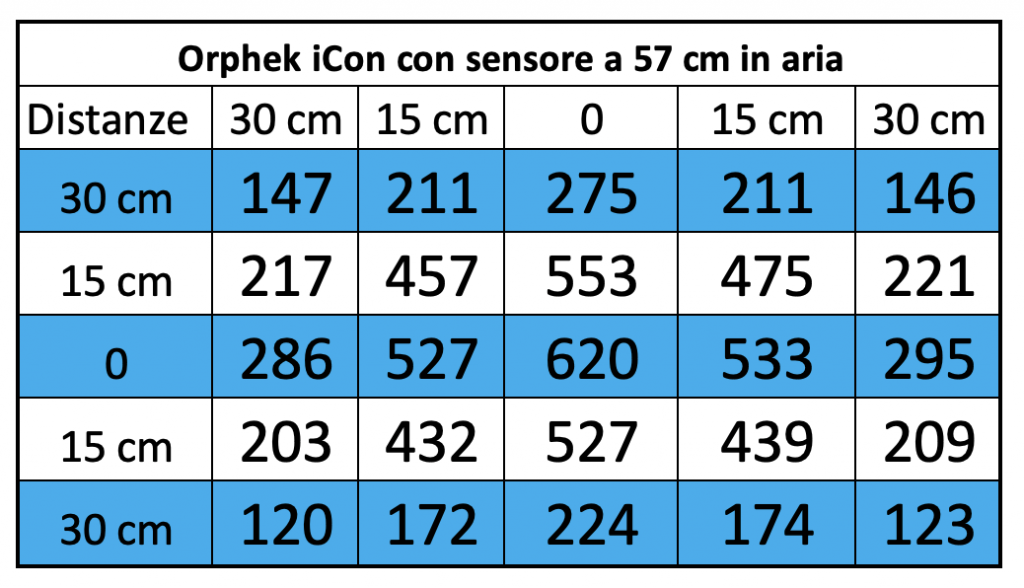
And this is the corresponding chart.
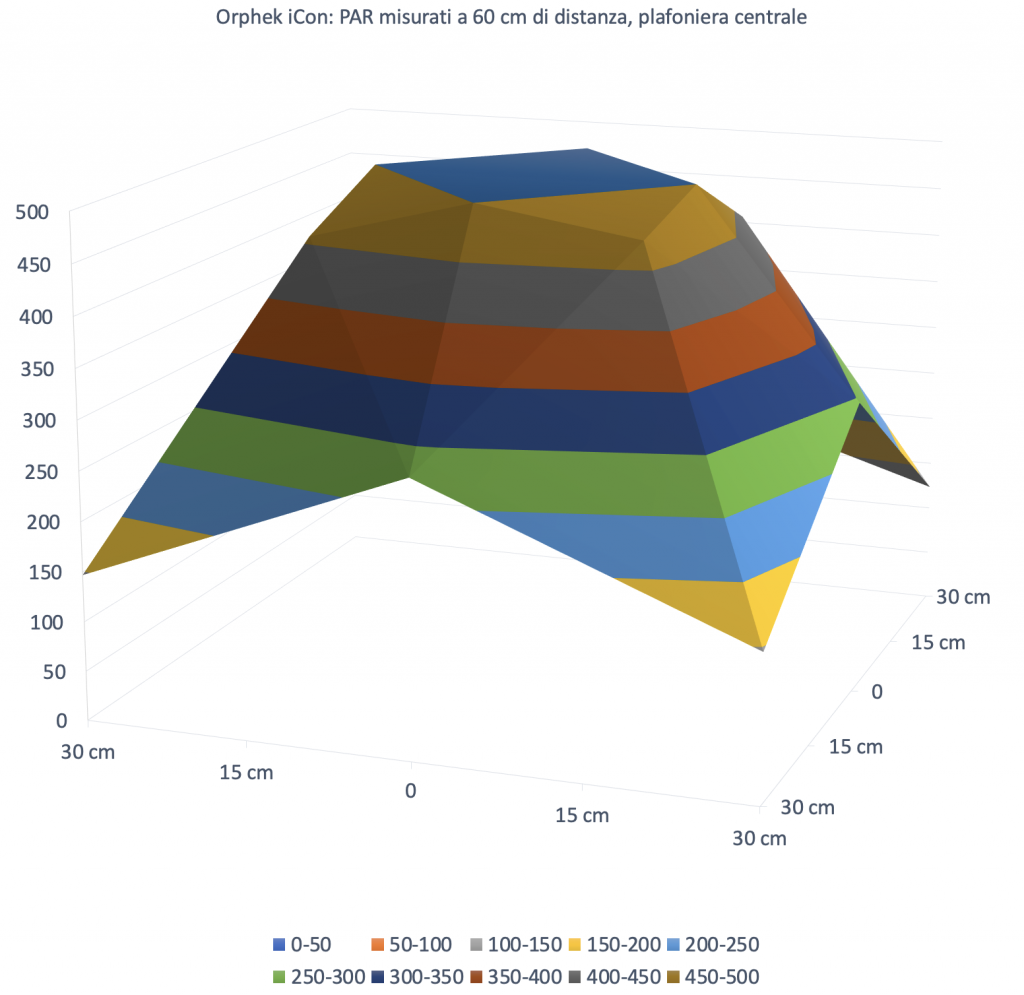
Until now, we’ve always used a chart with the maximum at 500 PAR. We thought we would never need to go further, but the iCon broke all the records, with 620 PAR in the middle! So we did a recalibration just for this ceiling light, so that you can better see the distribution of the light.
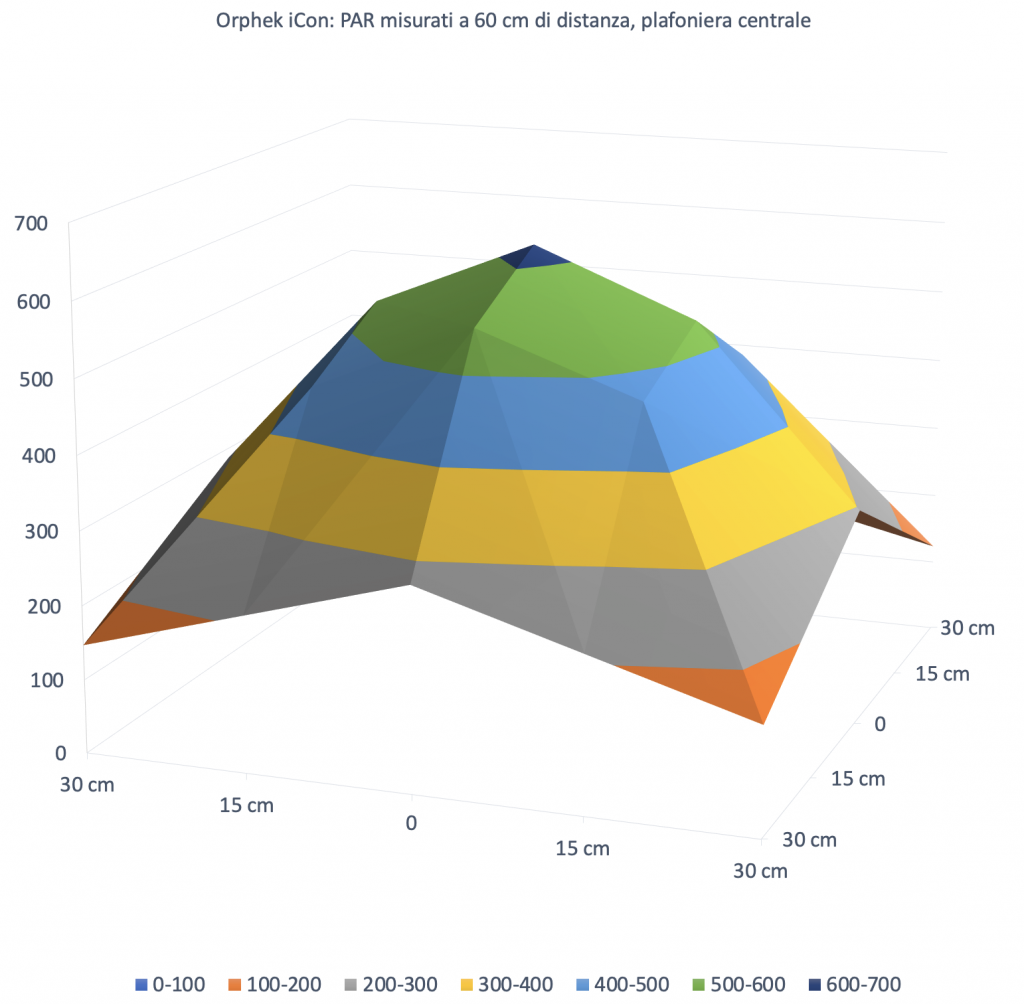
But if you want to compare the ceiling lights you have to refer to the first chart.
You only have to look at the charts to understand the power expressed along the central line of the ceiling light. The value in the middle decreases even more from 1774 to 966 to 620 μmol m-2 s-1.
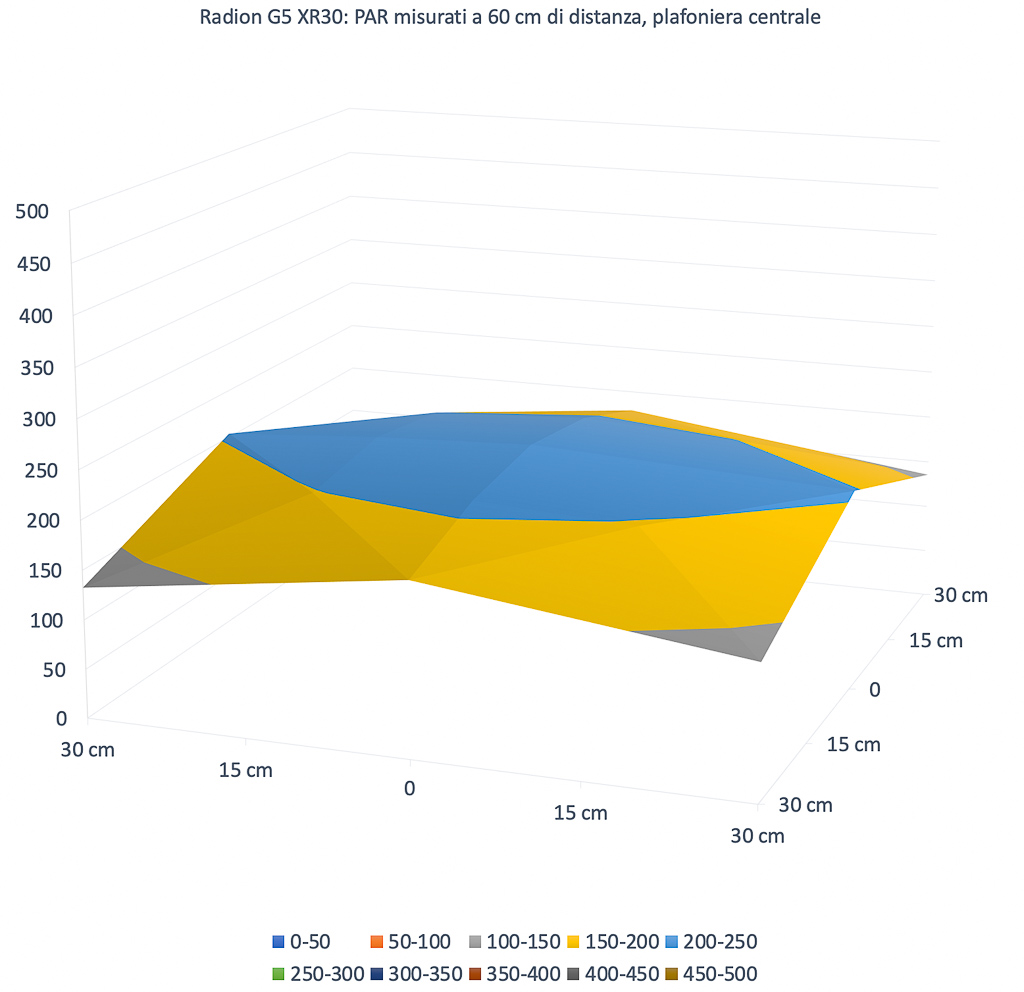
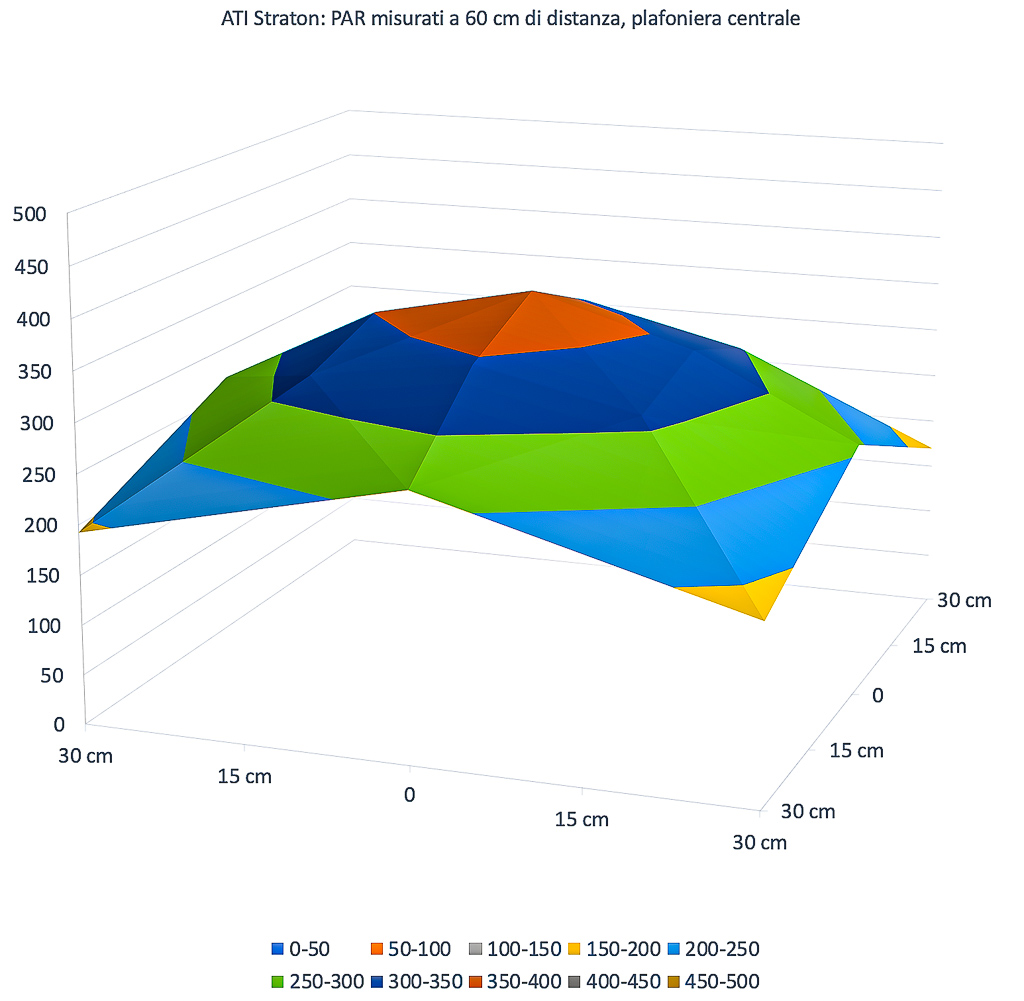
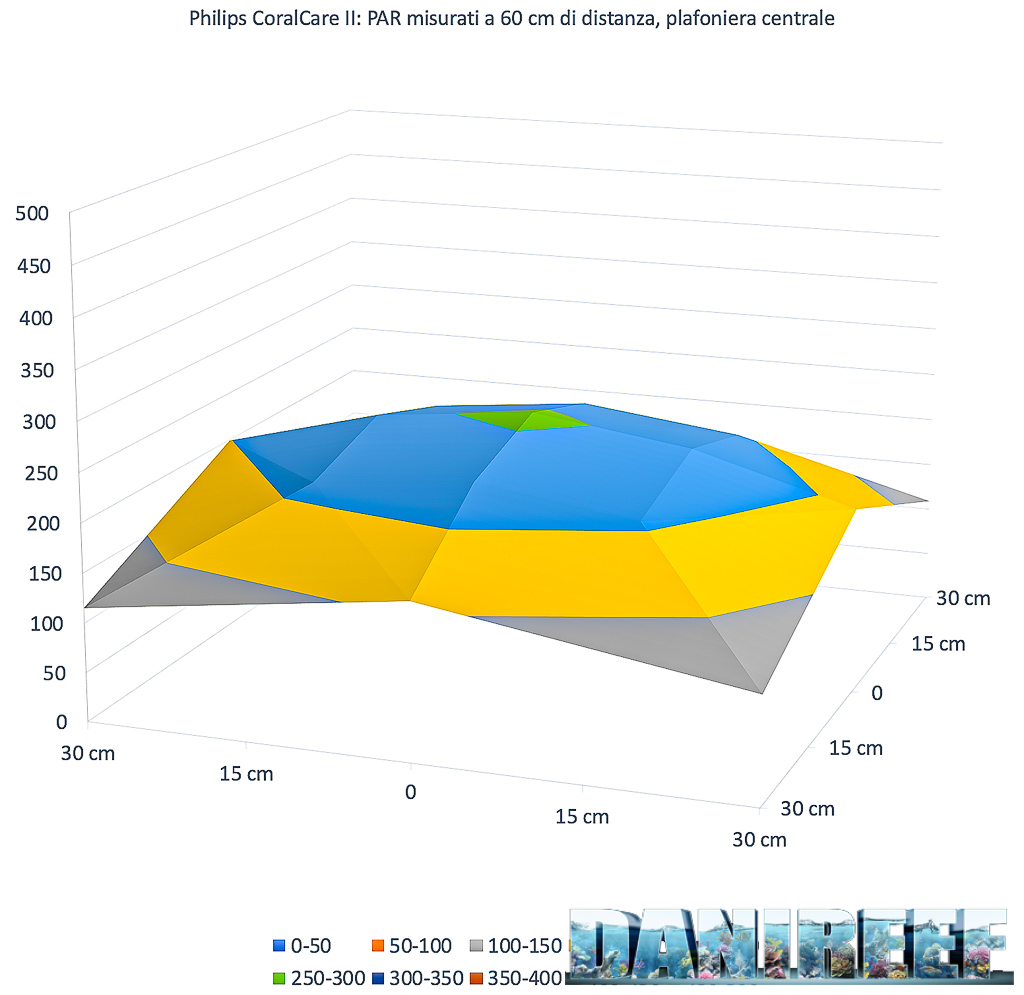
The differences are the same as at 37 cm. At this distance, the Orphek is even more impressive, while the other ceiling lights can claim more coverage on the sides. The Straton performs better than the others, but remember the difference of power among the ceiling lights.
The PAR in the middle in the different configurations
Let’s continue with our technical measurements. We can see how, in a chart, the PAR collected in the middle decreases in the three different distances of our tests.
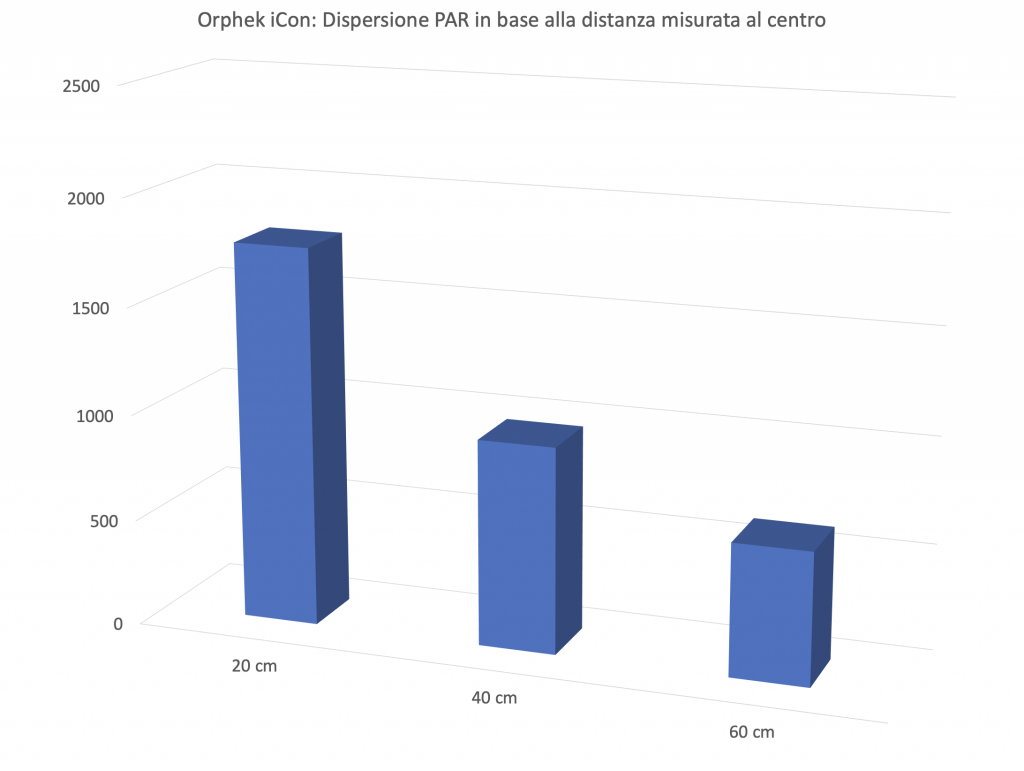
Energy variation of the Orphek Atlantik iCon depending on the distance
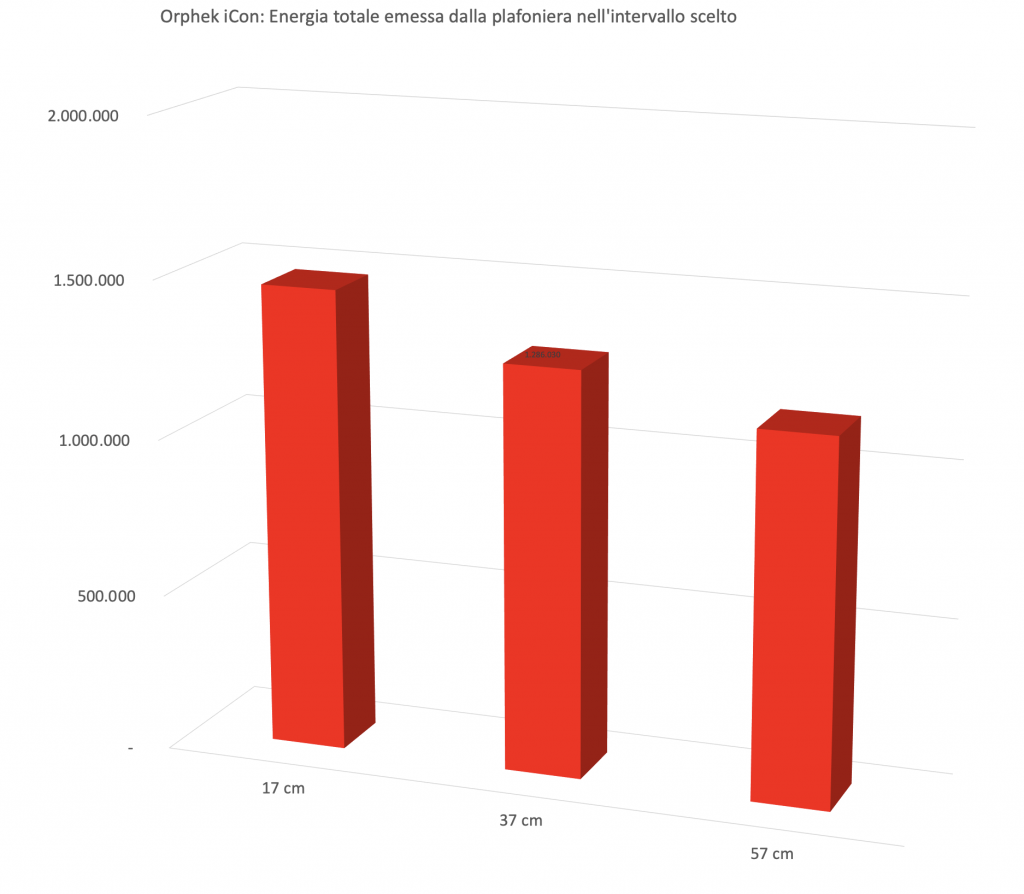
This is the most significant and most comparable data: the energy variation. We calculated the volumes of the three surfaces previously seen. Moving away from the ceiling light decreases the PAR, but the light illuminates a wider space. In this way you can consider all the light energy contained in the 60×60 cm area subtended by the ceiling light. And the three values of 1,469,474, 1,286,030 and 1,155,746 assume a different connotation compared to the values in the middle. When the first ones decrease because of the increase in distance, the subtended area, that is the energy, decreases less.
For the iCon the values are almost identical at the three distances, which means that whole expressed light or, at least, for the most part, remains inside the 60 cm. It’s perfect for tanks up to 60 cm long and wide, and less so for 70 cm, 80 cm, or even bigger aquariums.
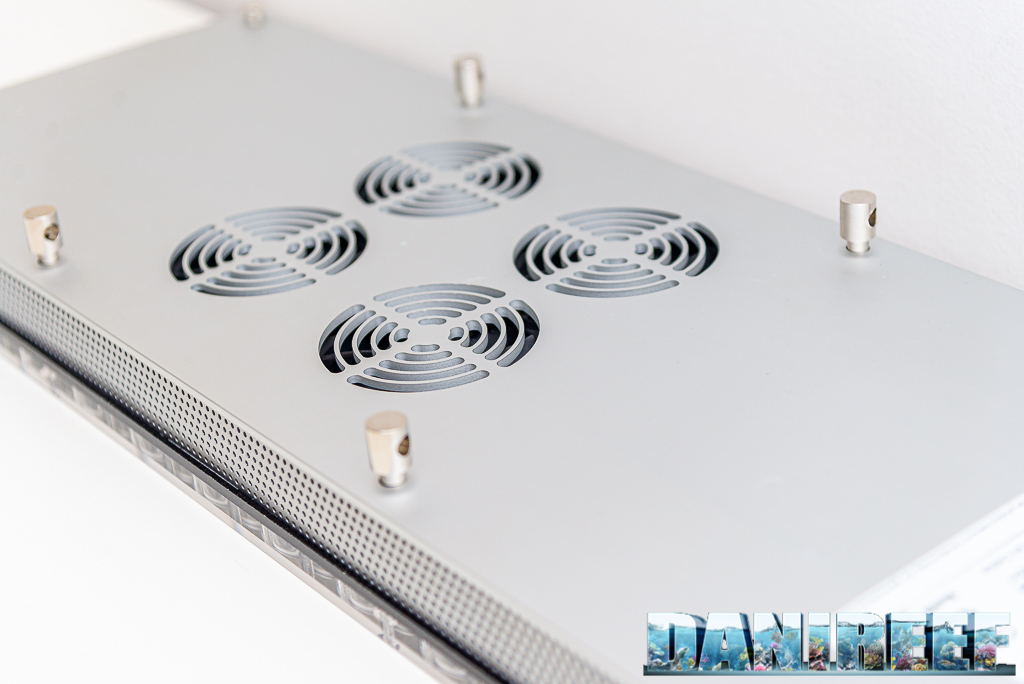
Values per channel in the middle in the three distances
We also measured the values per each channel, but only in the middle, in order to give you an idea of the contribution of the different channels to the PAR produced.
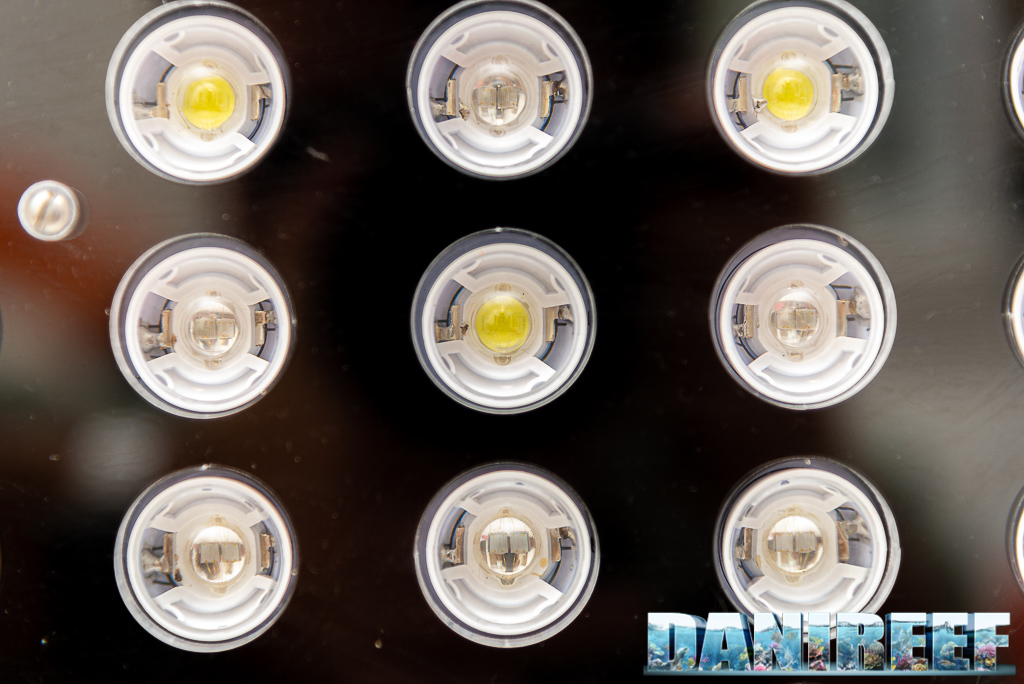
Let’s see the measured values:
| Distance= 17 cm | Distance= 37 cm | Distance= 57 cm | |
| Channel 1: Dawn and sunset (6000K) | 91 μmol m-2 s-1 | 100 μmol m-2 s-1 | 80 μmol m-2 s-1 |
| Channel 2: Solar noon (18,000K) | 422 μmol m-2 s-1 | 189 μmol m-2 s-1 | 111 μmol m-2 s-1 |
| Channel 3: Cyan blue (490nm, 470nm) symbiotic protection | 243 μmol m-2 s-1 | 157 μmol m-2 s-1 | 106 μmol m-2 s-1 |
| Channel 4: Blue (447nm) Chlorophyll c2 | 422 μmol m-2 s-1 | 189 μmol m-2 s-1 | 115 μmol m-2 s-1 |
| Channel 5: Purple (420-430 nm) Chlorophyll a and c2 | 436 μmol m-2 s-1 | 197 μmol m-2 s-1 | 120 μmol m-2 s-1 |
| Channel 6: UV/Purple (400-415 nm) Chlorophyll a | 261 μmol m-2 s-1 | 146 μmol m-2 s-1 | 92 μmol m-2 s-1 |
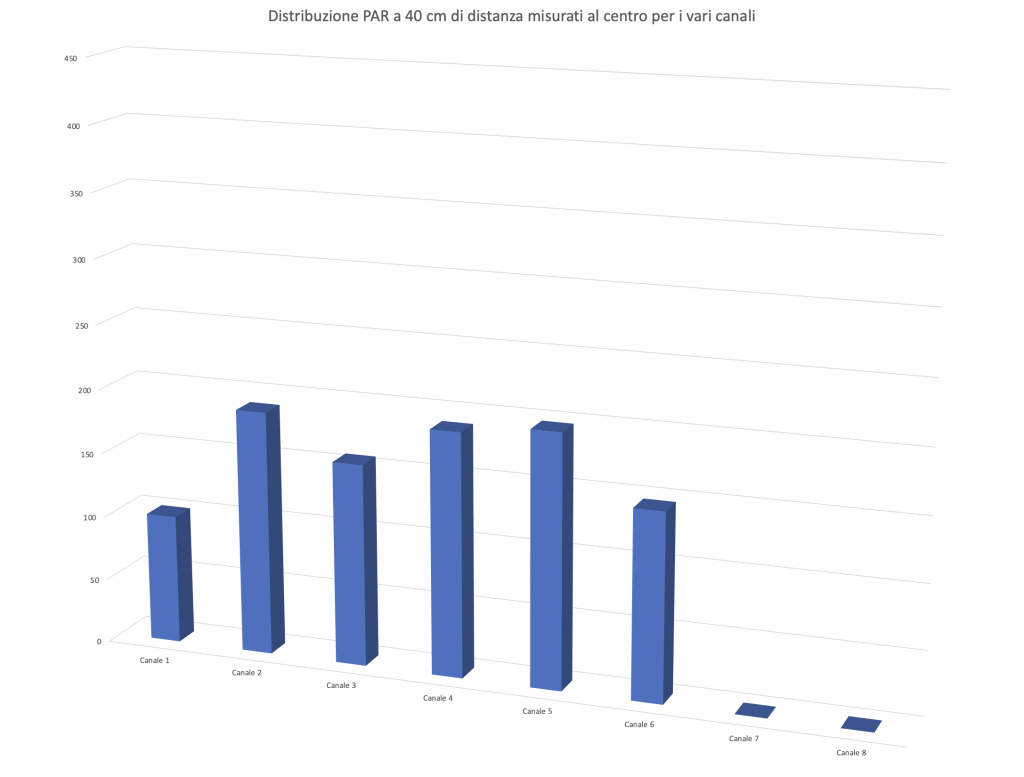
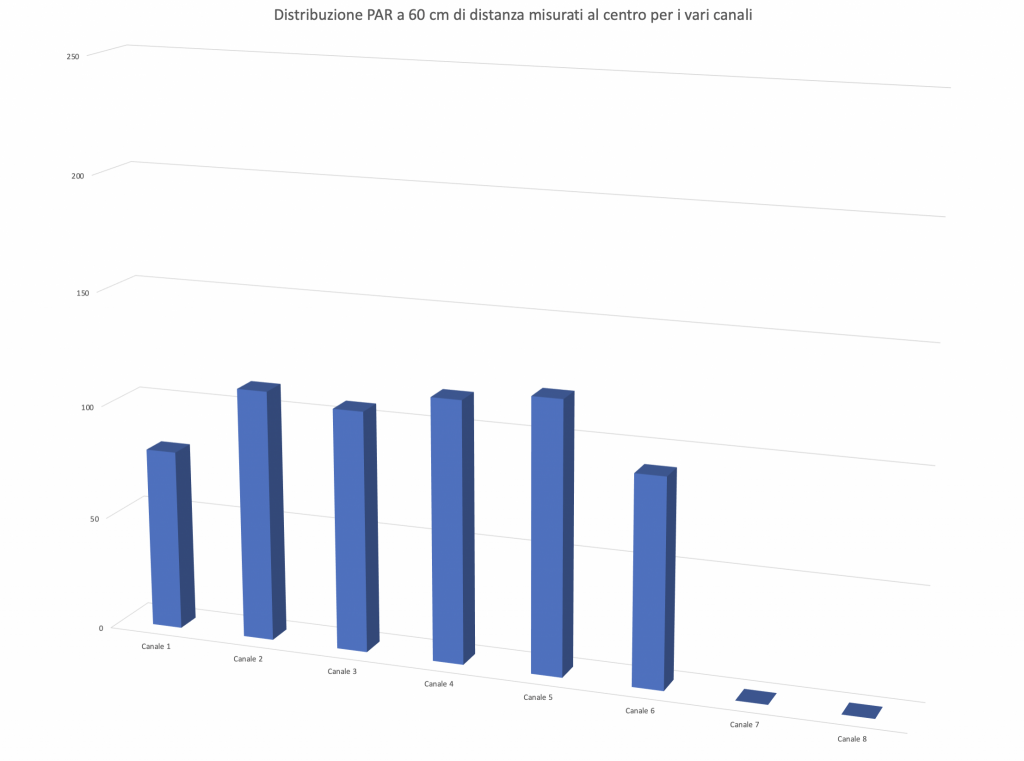
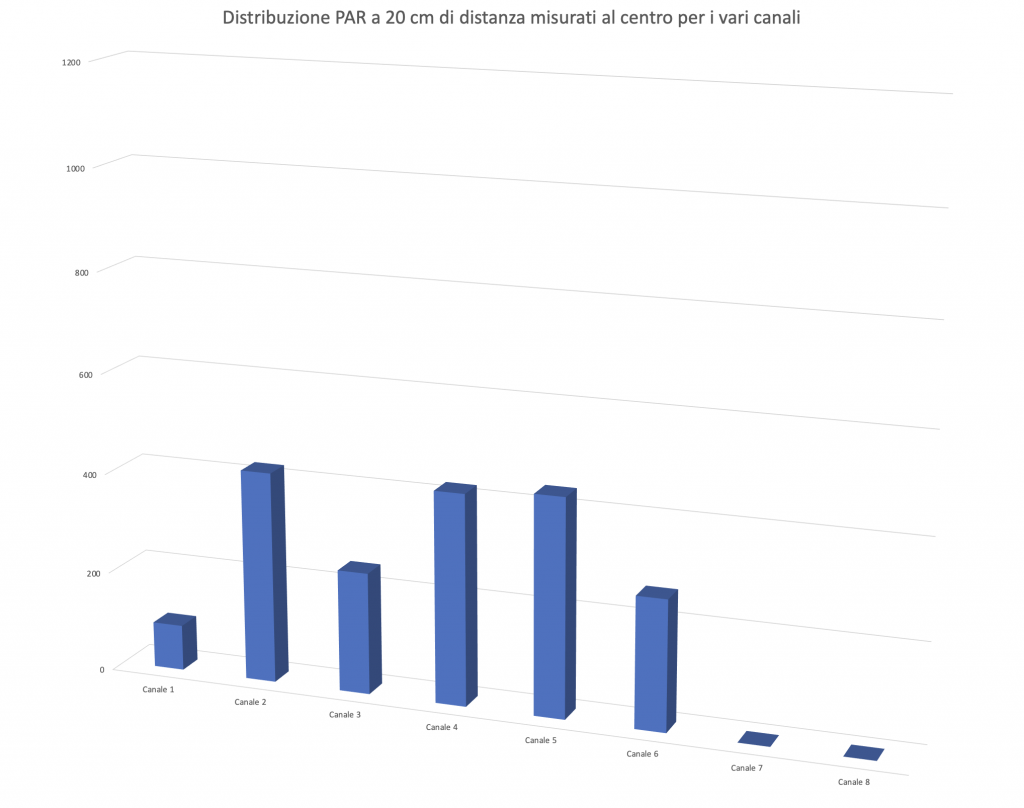
The five channels aren’t very different from each other. Also, the singular impact changes greatly with the distance, probably because when they’re very close to the device, the light doesn’t spread enough to affect it completely. Channels 2, 4, and 5 are the ones with the most PAR and with the exception of the first, the whitest of all, the others are all pretty close at 40 cm.
Consumption
The measurement of the consumption was made possible thanks to the useful RCE PM600 that can also measure the Cos(fi) (or power factor). The result is already given in watts.
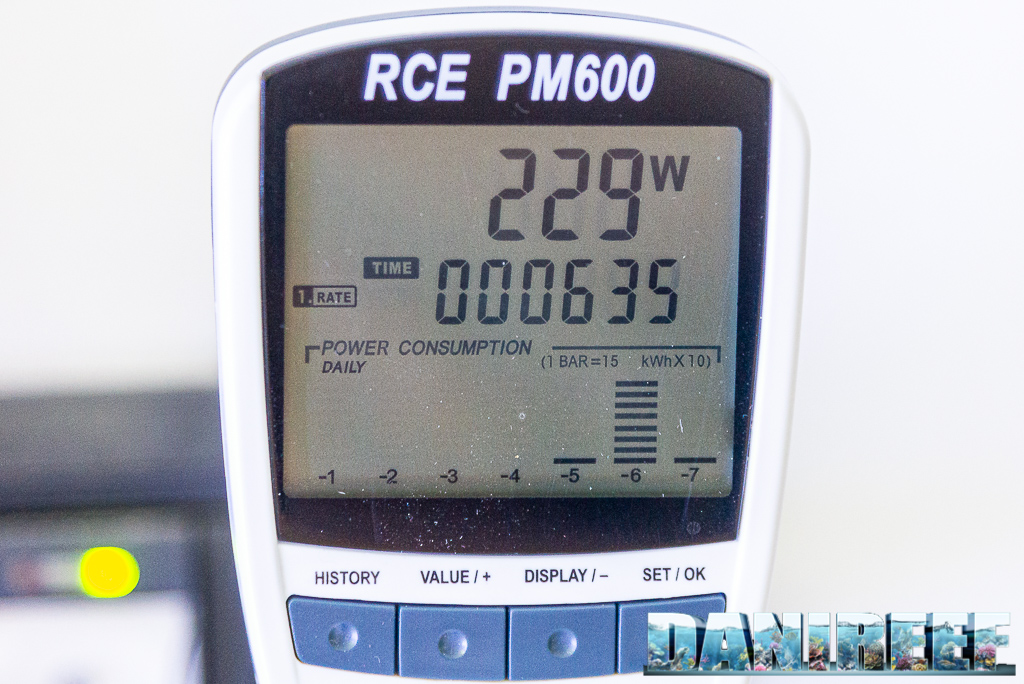
The Orphek Atlantik iCon consumes 229 watts. Identical to the declared of 230. Great! Considering that at 17 cm the ceiling light has 1774 μmol m-2 s-1 in the middle, we can say, in perspective, that its peak value will be of 7.74 μmol m-2 s-1 w-1 (PAR per watt).
Orphek iCon and heat
The Orphek iCon has both an active and a passive cooling system, and uses four vents controlled by a sensor on the PCB. In addiction, the external shell is in aluminum in order to better spread the heat.
How to value these numbers in an aquarium?
This is a good question. At first we thought that we could transport these values to the aquarium tout-court. Then we filled the aquarium, inserted the probe, and redid the measurements. Basically, while at 20 cm the result is practically the same, as we progressed, thanks to the glass and the water itself reflecting the light, we found up to double of the values measured in air. Obviously this isn’t a detail that can be standardized, so we think that our method of calculation is the most correct, and the best for the comparison of coverages of different ceiling lights.
The comparison with other ceiling lights on the market
The data detected in our DaniReef LAB have been collected through the Quantum Meter MQ-510 by Apogee.
| Energy | Cost | Consumption | Energy/€ | Energy/W | |
| AI Hydra 32 HD at 17 cm | 560.000 | 430 | 90,50 | 1.303 | 6.190 |
| AI Hydra 32 HD at 37 cm | 563.000 | 430 | 90,50 | 1.310 | 6.224 |
| AI Hydra 32 HD at 57 cm | 463.000 | 430 | 90,50 | 1.076 | 5.112 |
| Aqamai LRM at 17 cm | 643.000 | 465 | 90,88 | 1.382 | 7.071 |
| Aqamai LRM at 37 cm | 722.000 | 465 | 90,88 | 1.552 | 7.941 |
| Aqamai LRM at 57 cm | 616.000 | 465 | 90,88 | 1.326 | 6.783 |
| Aqamai LRS at 17 cm | 276.000 | 289 | 47,59 | 955 | 5.797 |
| Aqamai LRS at 37 cm | 312.000 | 289 | 47,59 | 1.078 | 6.547 |
| Aqamai LRS at 57 cm | 254.000 | 289 | 47,59 | 880 | 5.343 |
| ATI Straton at 17 cm | 2.018.232 | 890 | 211 | 2.268 | 9.565 |
| ATI Straton at 37 cm | 1.409.595 | 890 | 211 | 1.584 | 6.681 |
| ATI Straton at 57 cm | 957.209 | 890 | 211 | 1.076 | 4.537 |
| Cetus 2 at 17 cm | 410.000 | 215 | 60,68 | 1.906 | 6.756 |
| Cetus 2 at 37 cm | 291.000 | 215 | 60,68 | 1.353 | 4.793 |
| Cetus 2 at 57 cm | 174.000 | 215 | 60,68 | 807 | 2.861 |
| Ecotech Marine Radion G5 XR30 Blue at 17 cm | 1.535.561 | 949 | 203 | 1.618 | 7.564 |
| Ecotech Marine Radion G5 XR30 Blue at 37 cm | 1.097.933 | 949 | 203 | 1.157 | 5.409 |
| Ecotech Marine Radion G5 XR30 Blue at 57 cm | 647.940 | 949 | 203 | 683 | 3.192 |
| Orphek iCon at 17 cm | 1.469.474 | 1.350 | 229 | 1.177 | 6.417 |
| Orphek iCon at 37 cm | 1.286.030 | 1.350 | 229 | 1.030 | 5.616 |
| Orphek iCon at 57 cm | 1.155.746 | 1.350 | 229 | 925 | 5.047 |
| Orphek OR2 Blue Plus 120 cm at 17 cm | 323.000 | 180 | 54,69 | 1.794 | 5.906 |
| Orphek OR2 Blue Plus 120 cm at 37 cm | 291.000 | 180 | 54,69 | 1.616 | 5.321 |
| Orphek OR2 Blue Plus 120 cm at 57 cm | 259.000 | 180 | 54,69 | 1.438 | 4.736 |
| Orphek OR2 Reef Day Plus 120 cm at 17 cm | 255.000 | 180 | 54,69 | 1.418 | 4.667 |
| Orphek OR2 Reef Day Plus 120 cm at 37 cm | 233.000 | 180 | 54.69 | 1.292 | 4.252 |
| Orphek OR2 Reef Day Plus 120 cm at 57 cm | 225.000 | 180 | 54.69 | 1.251 | 4.117 |
| Philips CoralCare at 17 cm | 1.859.000 | 749 | 190,5 | 2.481 | 9.756 |
| Philips CoralCare at 37 cm | 1.341.000 | 749 | 190,5 | 1.790 | 7.037 |
| Philips CoralCare at 57 cm | 933.000 | 749 | 190,5 | 1.246 | 4.899 |
| Philips CoralCare Gen2 at 17 cm | 1.330.430 | 749 | 168,5 | 1.780 | 7.914 |
| Philips CoralCare Gen2 at 37 cm | 920.277 | 749 | 168,5 | 1.229 | 5.461 |
| Philips CoralCare Gen2 at 57 cm | 631.087 | 749 | 168,5 | 843 | 3.745 |
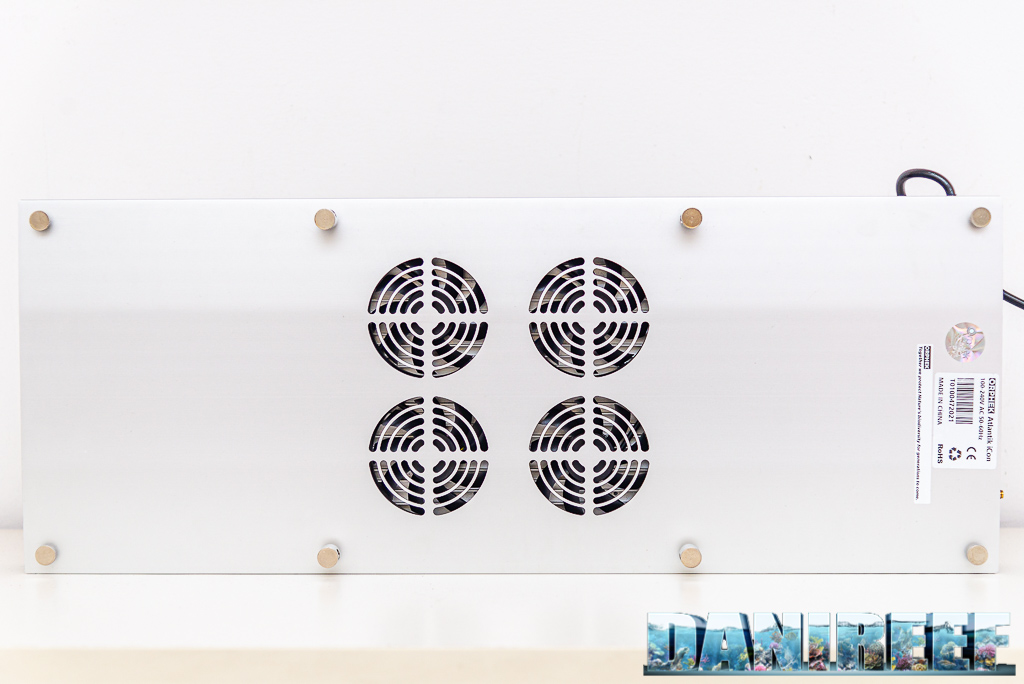
Considering the energy per watt, the PAR, and the energy per euro, the ceiling light is average. What stands out it the power at 60 cm, incredibly high. All the data suggests that this ceiling light is perfect for aquariums up to 60 cm, max 70 cm, considering that the corals are never placed right next to the glass.
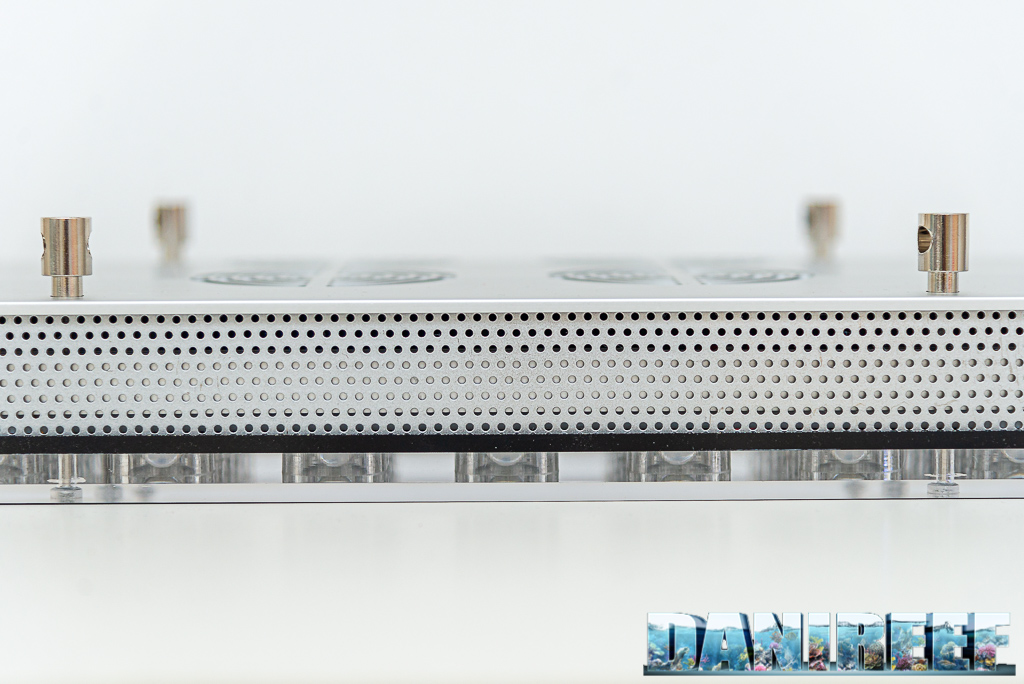
Maintenance costs
The Orphek Atlantik iCon costs 1,350 euro ($1419 USD).
The absorbed power is 229 watts, so it has a cost/watt ratio of about 5.89 euro/watt ($6.20/watt). For a comparison with the other ceiling lights you can consult the following chart. They’re sorted by decreasing efficiency, so the best are the first ones.
| Ceiling light | Price | Consumption | Euro per watt ratio | References |
| Orphek OR2 Blue Plus | 180 USD | 54.7 w | 3,3 euro per watt | DaniReef LAB |
| Orphek OR2 Reef Day Plus | 180 USD | 54,7 w | 3,3 euro per watt | DaniReef LAB |
| Cetus 2 | 215 € | 60,7 w | 3,5 euro per watt | DaniReef LAB |
| Philips Coralcare 2019 | 749 € | 190 w | 3,9 euro per watt | DaniReef LAB |
| Maxspect Ethereal | 500 € | 126 w | 4,0 euro per watt | Italian test |
| ATI Straton | 890 € | 211 w | 4,22 euro per watt | DaniReef LAB |
| Philips CoralCare GEN2 2020 | 749 € | 168,5 w | 4,44 euro per watt | DaniReef LAB |
| Ecotech Marine Radion XR30 G5 Blue | 949 € | 203 w | 4,67 euro per watt | DaniReef LAB |
| Radion XR30w G2 PRO | 790 € | 170 w | 4,7 euro per watt | Italian review |
| AI Hydra 32 HD | 430 € | 90,5 w | 4,75 euro per watt | DaniReef LAB |
| Radion XR30w G4 PRO | 915 € | 190 w | 4,84 euro per watt | Italian article |
| OceanLed Sunrise 600 | 870 € | 180 w | 4,8 euro per watt | Italian test |
| Orphek Atlantik V4 | 1099 € | 226 w | 4,9 euro per watt | Test |
| Radion XR30w G2 | 690 € | 140 w | 4,9 euro per watt | Italian review |
| Radion XR30w G4 | 760 € | 150 w | 5,1 euro per watt | Italian article |
| Aqamai LRM | 465 € | 87,5 w | 5,1 euro per watt | DaniReef LAB |
| Zetlight UFO ZE-8000 | 500 € | 91,5 w | 5,5 euro per watt | Test |
| Orphek iCon | 1.350 € | 229 w | 5,89 euro per watt | |
| Aqamai LRS | 289 € | 47,6 w | 6,1 euro per watt | DaniReef LAB |
| CEAB Slide & Led | 2.700 € | 275 w | 9,8 euro per watt | Review |
| Sicce GNC 466 | 1.592 € | 120 w | 13,3 euro per watt | Review |
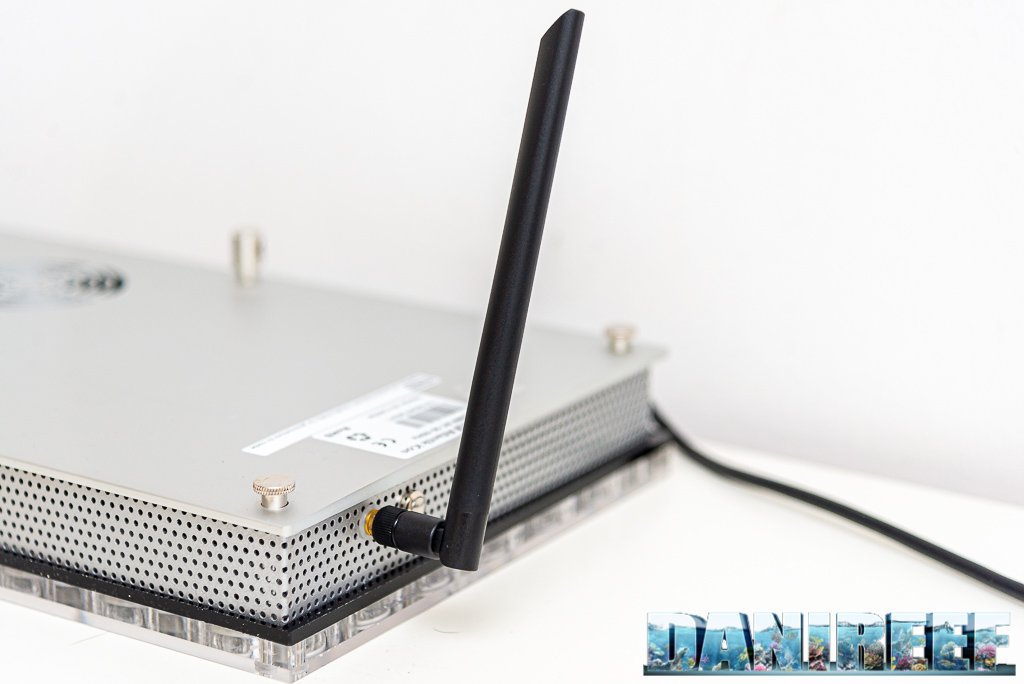
The ceiling light is very well built, heavy and solid. You can see the improvement in relation to the previous V4. The price reflects the quality.
The energy efficiency is average, the economic efficiency is lower. Which means if you want quality and power, you have to pay for it.
This chart is the spectral power distribution (SPD) in different depths, in clear saltwater:
| 1 m | 5 m | 10 m | 15 m | 20 m | |
| SPD (µmoli/M2/s) | 1640 | 958 | 618 | 436 | 316 |
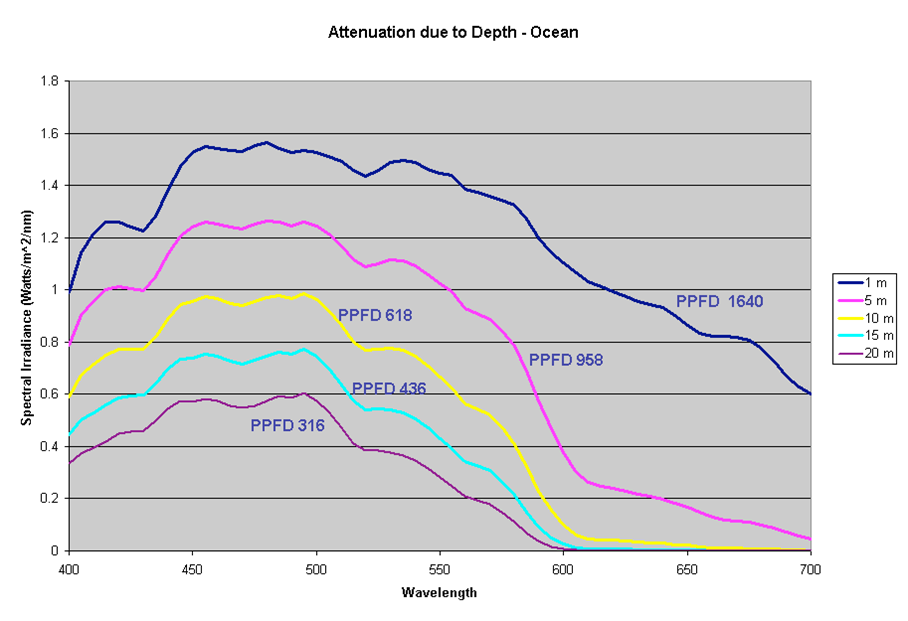
So, at 37 cm of distance an iCon obtains 966 µmoli/M2/s, which is approximately 5 meters below sea level. An outstanding power! We’re almost reaching the same values as sunlight.
These results show that this ceiling light is great for nanoreefs up to 60/70 cm per side, both for SPS and anything else. The expressed power is the best for the whole central line. On the front and back it drops a little, but it’s still at the same level of other ceiling lights. You can breed anything with every coloration. The only problem may be the length of the iCon, which is 61.5 cm. This might limit the use in some aquariums, but I think that 2 of them for an aquarium of 130 should be perfect. Maybe in a tank of 120 cm, you could couple it with another, smaller light.
Questions and comments, as usual, are very welcome.
The Orphek iCon has been sent by Orphek in order to do this evaluation, if you are a company and want us to evaluate your lights, feel free to contact us.
[Translated by Agnese Poggi]










0 Comments